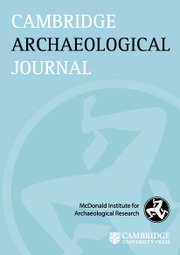In 1995, while working up the south-facing slope of a section ultimately designated Tsagaan Salaa IV (TS IV), we came to a level high above the river floor. The terrace was covered with stones, many decorated with images; but the boulder that immediately seized our attention lay at the very edge of the terrace, looking south over the broad river valley (Fig. 1) and east down Baga Oigor Gol (Fig. 2). The stone itself was remarkable, being a huge mass, broken at one end, rounded on the sides and its upper surface deeply scraped and polished by glacial action. Its smoothed but fractured character, its elegant surface texture and its location there on the edge of the terrace indicated that it must have been entrained and left there by an ancient glacier from either higher up the valley or from the top of the ridge. Yet impressive as was the boulder, even more striking was the nature of its decoration. In all respects—geological significance, setting and remarkable pictorial elements—this boulder was clearly much more than an archaeological datum: it seemed to reflect a complex interweaving of deep geological time, iconography and its social implications. Most significantly, a consideration of this strange image within its larger tradition promised to reveal the psychological orientation underlying evolving cultural norms.

Figure 1. Boulder with large, stylized elk. View to the south and the peak of Taldagiin Ikh Uul. Baga Oigor complex, TS IV. (Photograph: Gary Tepfer.)
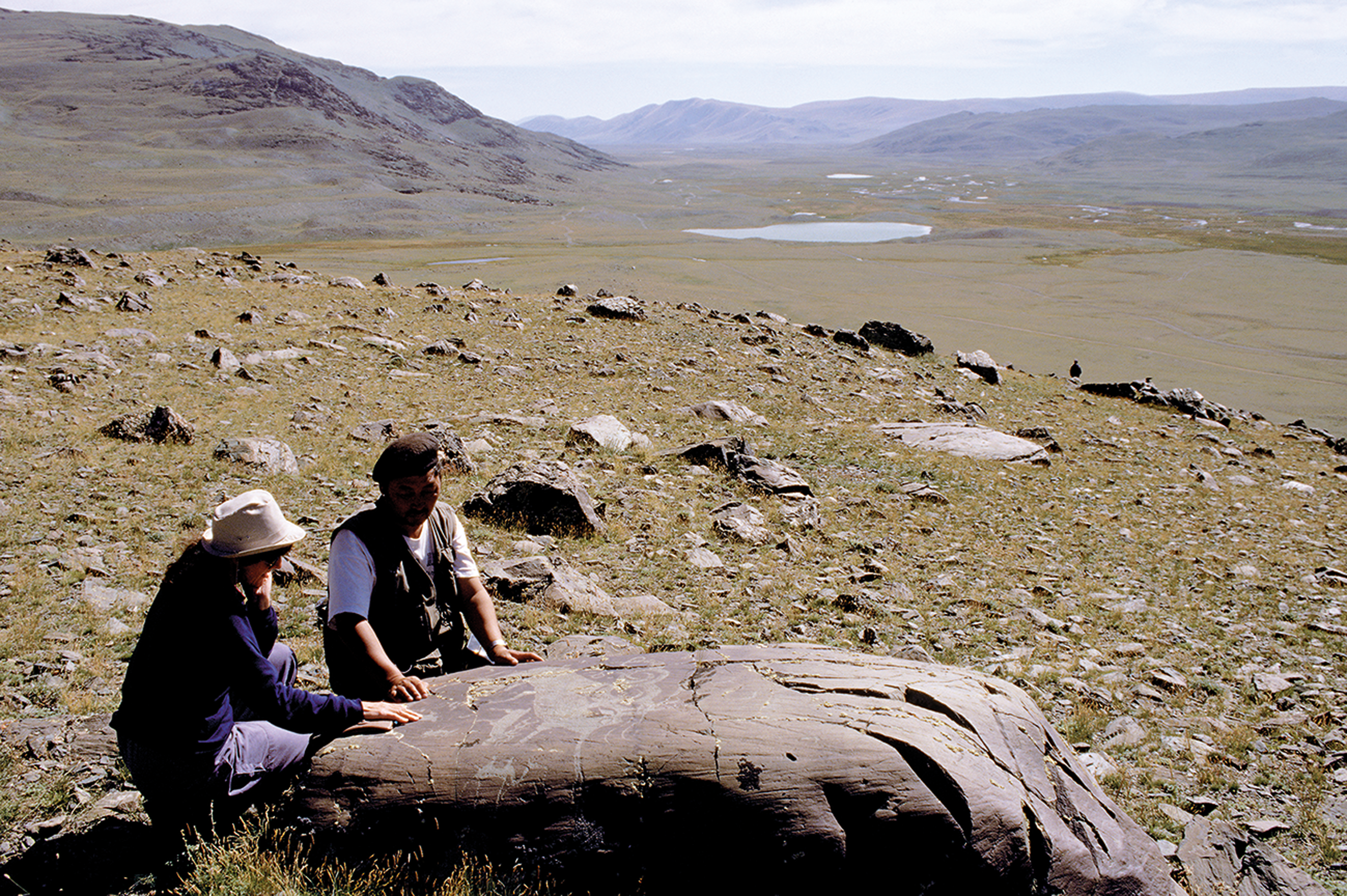
Figure 2. Boulder with large, stylized elk. View east down Baga Oigor Gol. Baga Oigor complex, TS IV. (Photograph: Gary Tepfer.)
The surface of the boulder is dominated by the image of a large bull elk, while around that animal are several more or less realistic elk and caprids. The large stag’s body is long and fully pecked out, the precision and density of the pecking unusually fine (Fig. 3). In this respect, the image demands attention. At the same time, the animal is strange, with vestigial legs and a head drawn out into a long, bird-beak-like structure. The elk’s eye is large and round, its one visible ear elegantly rendered, but its shoulders take the form of an unnaturally sharp peak. In addition to its beak-like head, the animal’s most arresting aspect are its huge, elaborately coiled antlers stretching back over its back (Fig. 4) and balanced by two thin, projecting forehead tines.

Figure 3. Stylized elk, detail of whole animal in Figures 1 & 2. (Photograph: Gary Tepfer.)
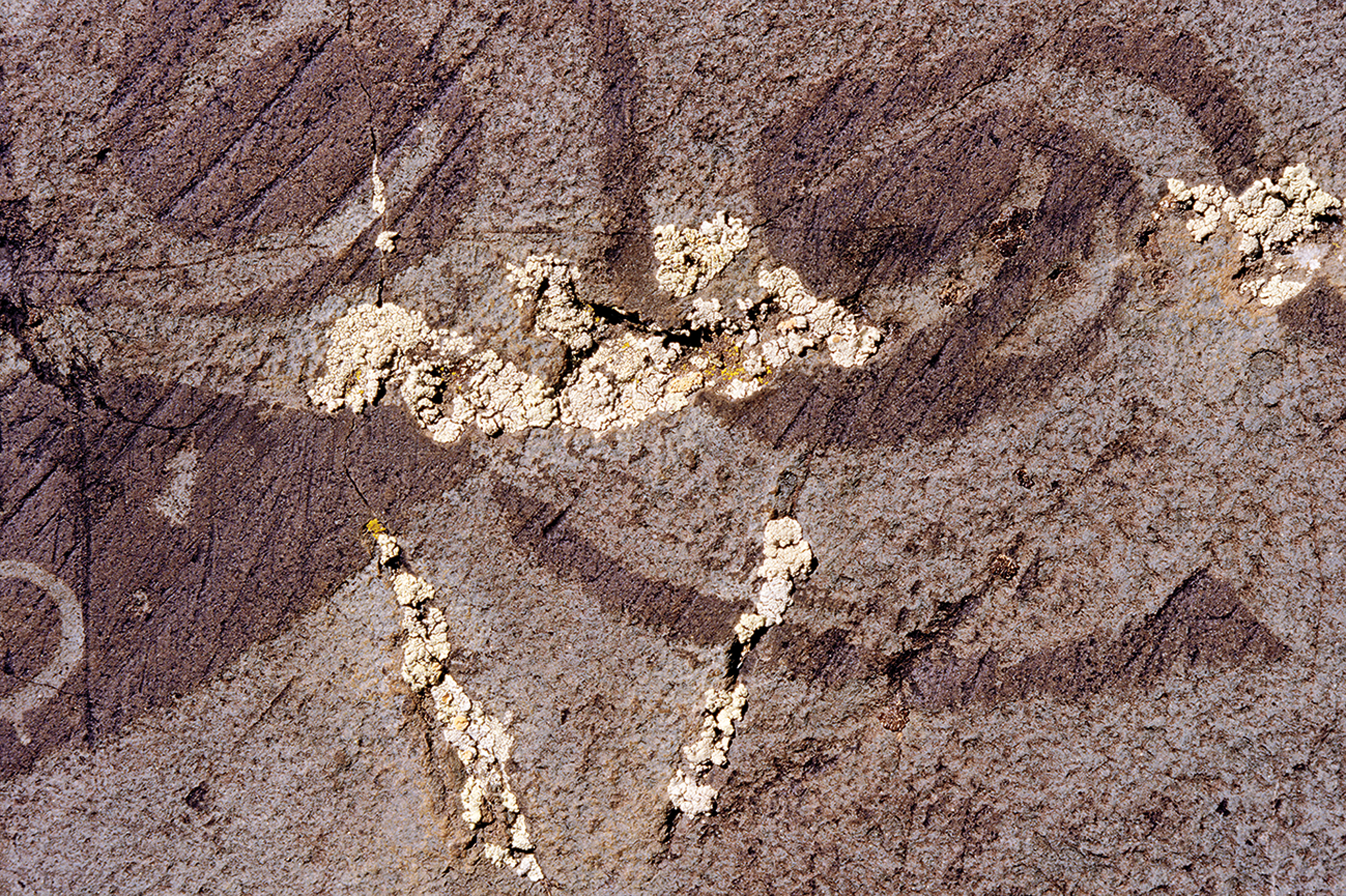
Figure 4. Detail of elk antlers showing density of the pecking and the clarity of contours. (Photograph: Gary Tepfer.)
This was not the first time our team had encountered such a strangely stylized elk, nor was it necessarily the largest that we have recorded. It is, however, one of the most perfectly executed examples of this peculiar type. The whole animal has been densely executed with a pecking technique that is shallow and even. The figure’s contours are still clear, despite the almost three millennia it has graced the boulder and despite the intrusions of lichen-filled cracks. We dubbed this image the ‘Mongolian deer’, because it belongs to a genre of imagery best known from the so-called Mongolian deer stones of central Mongolia (Bayarsaikhan Reference Bayarsaikhan2022; Jacobson-Tepfer Reference Jacobson-Tepfer2023; Volkov [1981] Reference Volkov2002). That imagery is often radically stylized, to the point that the cervid character is almost lost except through the appearance of elaborate antlers suggesting the unfurling of large wings. In this case, the fusion of the elk’s head with that of a long-beaked bird is quite explicit. At the time we came upon this elk image and the transformation it represents, there had been no discussion of such imagery except within the context of the deer stone monument type. The complex cultural forces underlying this image were still essentially hidden.
To the south the boulder looks across to the snow-crested mountain, Taldagiin Ikh Uul (Fig. 1); to the east its viewshed takes in the valley of Baga Oigor Gol (Fig. 2). The boulder’s decoration—so bizarre in its references and yet so confidently executed—raises the problem of naming subjects in Altai rock art without prejudicing meaning. It is one thing to identify the image as that of a bull elk, a single instance within an ancient tradition of representing that animal; but it is quite another to understand why the unknown artist had so denatured the real beast that the term ‘elk’ hardly indicates why it was so reminiscent of a winged bird. Throughout the subsequent years of our survey of rock-art complexes in northwestern Bayan Ölgiy, it became clear that this curious animal underwent even more transformation, ultimately becoming a fusion of wolf and elk, of predator and prey.
A representation of the antlered cervid in Altai rock art may be that of an elk, a moose, or a reindeer; here the focus is on the animal with the scientific designation of Cervus elaphus. Both male and female forms persisted over a longer period of time than that of any other zoomorphic representation in Altai rock art. The mature bull elk image appeared in rock art of the late Palaeolithic (Fig. 5), alongside disappearing megafauna such as mammoths, woolly rhinoceros and ostrich, and together with the primitive aurochs and horses of the harsh steppe (Jacobson-Tepfer Reference Jacobson-Tepfer2013; Tseveendorj et al. Reference Tseveendorj, Kubarev and Yakobson2005). The elk seems to have lasted through a long pictorial lacuna covered by the early and middle Holocene (c. 9000–6500 bp), reappearing in rock art of the Bronze Age (c. 5000–2800 bp ) and surviving into the early Iron Age (mid–late first millennium bce). By the Turkic Period within the Mongolian Altai (fifth–eighth century ce ), the elk image had disappeared. This probably reflects the withdrawal of the animal from most of the eastern (Mongolian) side of the Altai range as a result of the extensive loss of forest land.

Figure 5. Altai region of northwestern Mongolia: concordance of geological periods, environmental conditions, vegetation and faunal regimes and broad cultural periods.
Antlered or not, the elk image is often referred to as that of a ‘deer’, that is, a member of the family of Cervidae; but that terminology is too imprecise. Unfortunately, the names assigned to the animal we see in rock art of central and north Asia vary depending on the writer’s nationality and perspective. In the present, the animal with which we are concerned is known alternatively as elk or wapiti (Cervus canadensis in North America, central and east Asia), Altai wapiti (Cervus elaphus sibiricus), or Red Deer (Cervus elaphus). The fact is that all these regional variations on the elk are similar in size, pelage and environmental requirements. Just to confuse the matter even further, the animal known in North America as a moose (Alces alces) was formerly called ‘elk’ in Europe, and the highly stylized antlered animal on deer stones (Bayarsaikhan Reference Bayarsaikhan2022; Volkov [1981] Reference Volkov2002) was certainly an elk. For consistency’s sake, in the following discussion the term ‘elk’ will refer to Cervus elaphus sibiricus, the type associated with the Altai region for the last several thousand years, or to what others might call a wapiti or red deer.
The elk is the second largest of the family Cervidae, exceeded only by the moose. The male elk, referred to alternatively as a bull or stag, is antlered; the female, known as a doe or cow, is not. The bull’s rack can become extremely large, its tines branching up and back over its body. Like all other members of Cervidae, the elk loses its antlers annually. Males and females develop a full throat mane, though that of males is usually more impressive. Colouration is also varied, with the neck and head becoming darker with maturity; it is interesting to note that these variations were frequently reflected in the early rock-art images of elk (e.g. MAIC: RA_PETR_AT_00701). Throughout the Bronze Age, artists represented both bulls and does, sometimes together, sometimes even with young. Ordinarily one would assume that if the animal is antlered, it is a bull; but within the rock-art record of the late Bronze and early Iron Ages, that assumption may not always be correct: with the extreme stylization of the elk, its gender may have become immaterial by comparison to other symbolic references (Jacobson-Tepfer Reference Jacobson-Tepfer2015), and two antlered animals together may refer to a pair of elk or to a pair of male elk (Fig. 6).
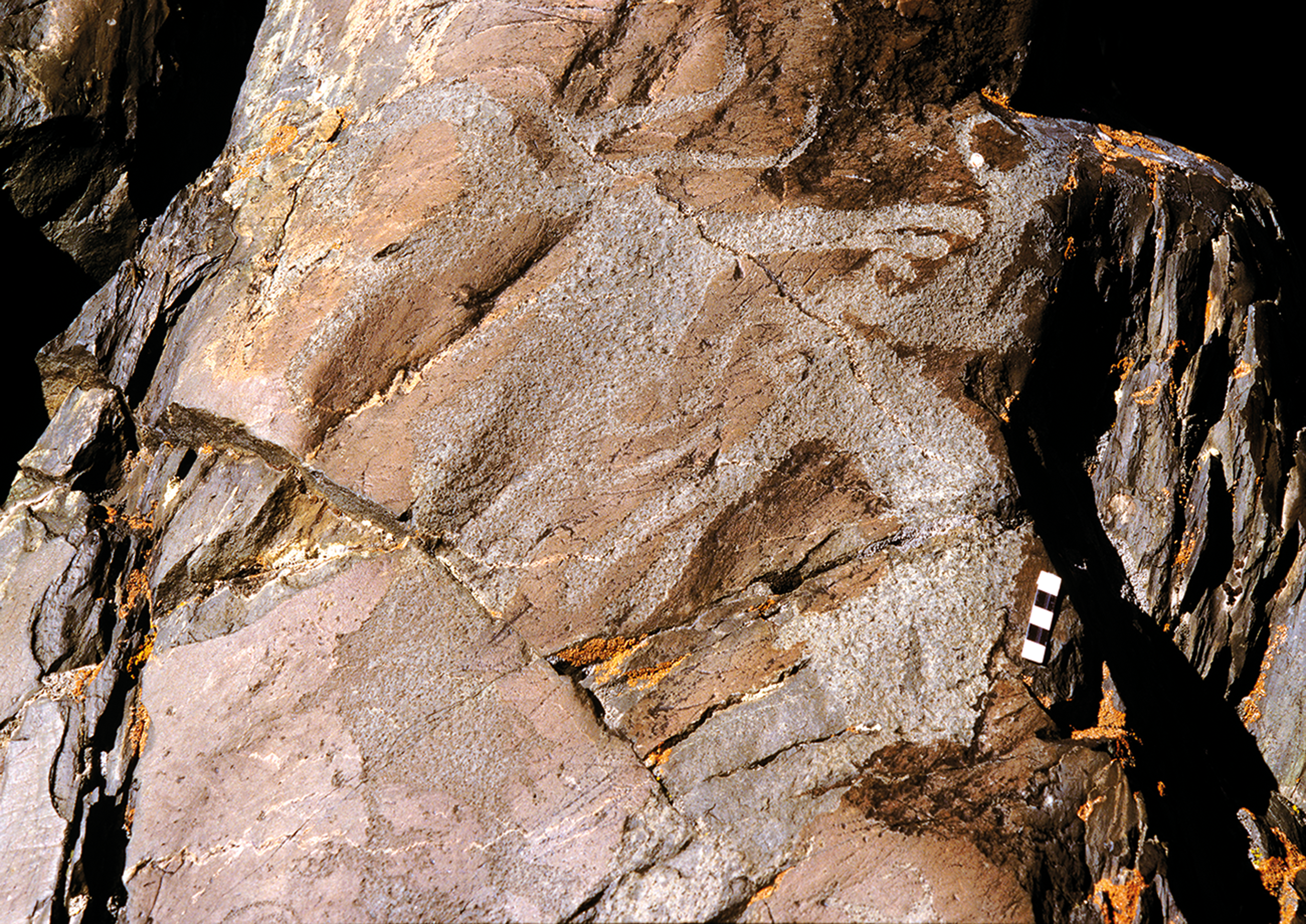
Figure 6. Pair of stylized elk, with bird-beak heads. Late Bronze Age. Tsagaan Gol complex, TG_0484. (Photograph: Gary Tepfer.)
Since the elk is both browser and grazer, it requires a variety of vegetation native to forest and grassland. During periods of deep snow, the animal retreats from the margins of open land into more protected woodlands where it can feed on vegetation and bark from trees and shrubs. It follows that within present-day Mongolian Altai, with its radically diminished or even disappeared forest cover, there is almost no habitat for elk. Except for a narrow band of larch forest along the Chinese border, tree cover sufficient to support a sizable elk population has probably not existed for more than 2000 years. It follows that as much as any other animal image, that of the elk reflects its palaeoenvironmental context and the vegetation regime ensuring its survival or disappearance. At the same time, the radical transformation of its representation over a long history reflects profound changes in human society and artistic expression.
Before considering petroglyphic elk imagery from the Altai region, it is necessary to clarify my measures for establishing chronology. These have been developed more fully elsewhere (Jacobson-Tepfer 2019; Reference Jacobson-Tepfer2020), but here I will summarize. With prehistoric rock art, chronology will always be general; nonetheless, there are certain considerations that help to constrain even general dating. The execution of the image—engraved, pecked, or scraped—is a primary consideration; within those distinctions, the method of pecking—direct or indirect—is of material importance. The presentation of the image—frontal or three-quarters view, contoured or silhouetted—may be an essential indicator of age. No less important is the style in which the image is presented: realistic, naturalistic, or stylized. Patina, observed as the re-darkening of pecked images, must be considered, but it is not always a reliable indicator of age. With reference to human representation and activities, weapons, tools and clothing are critical for dating, since they may offer parallels to archaeologically recovered materials or to larger technical studies. The details of certain human activities are also essential indicators of chronology; these include, for example, techniques of hunting and the appearance of horse and camel riding. Of course, all these indicators of possible chronology have to be considered within the corpus of local and regional materials, whether rock-art complexes or archaeological settings; and the broader the net of comparative imagery, the more reliable will be the proposed dating.
Perhaps the most important measure for establishing the relative dating of prehistoric imagery is drawn from the natural environment. Geology and climate directly constrain the vegetation regime (Fig. 5) and that, in turn, is immediately related to the faunal regime: it simply stands to reason that without their necessary sources of sustenance, animals retreat or withdraw to more propitious environments, or they simply disappear. Fortunately, there exists a great range of studies regarding environmental change in the Altai region and these have been consulted here (Klinge & Sauer Reference Klinge and Sauer2019). Finally, in speaking of animal imagery, I am convinced that prehistoric artists represented what they saw, not what they may have distantly remembered or imagined. In other words, almost all Altai imagery is rooted in the human perception of the phenomenal world.
In northwestern Mongolia, rock art dating from the post-glacial Palaeolithic period has been identified at two open-air complexes: Aral Tolgoi and Baga Oigor. Within that material, images of elk occur less frequently than do those of aurochs, wild horses, ibex and argali. This is perhaps not surprising: in that early period, mountainous northwestern Mongolia was still characterized by harsh steppe vegetation punctuated by occasional fragmentary forests, and the upper elevations—home to ibex and argali—were clear of tree growth (Gunin et al. Reference Gunin, Vostokova, Korofeyuk, Tarasev and Black1999). Those elk images that do occur are executed with the same monumental character as were the aurochs and horses (Fig. 7). In all cases, the animals’ bodies were rendered in terms of directly pecked contours, static profiles and, with the exception of their legs (frequently vestigial), they convey the impression of a direct realism.
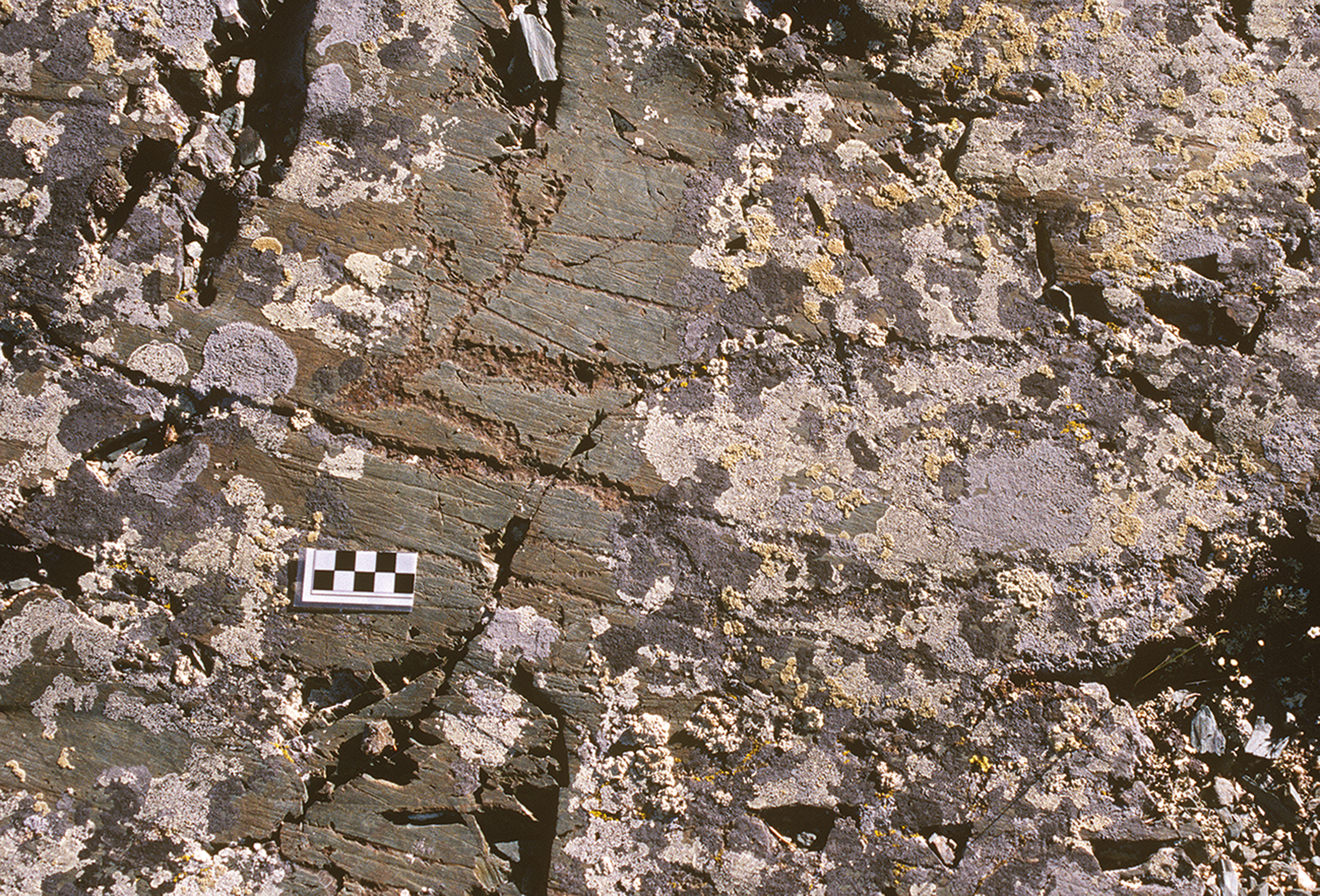
Figure 7. Fragmentary elk, possible contour of another animal. Palaeolithic. Aral Tolgoi, AT 23. (Photograph: Gary Tepfer.)
Within mountainous Bayan Ölgiy, there are only scattered indications of rock art during the long period of the early and middle Holocene (c. 10,000–5000 bp). Expanding forests and lakes undoubtedly inhibited human movement into the high mountains; if there were hunters and foragers in upper elevations, heavy vegetation would have discouraged any interest in pecking imagery on stone surfaces, even that of the elk, which by then were certainly inhabiting the forests and their borderlands. It is probable that during that long period through the middle Holocene (c. 8000–5000 bp), the high valleys within which Aral Tolgoi, the Tsagaan Gol and Baga Oigor complexes are situated were thinly and irregularly populated. Extensive marshes and high lake levels would have discouraged people still completely dependent on their own physical strength for movement. There is no indication from that period that people living in the mountainous region had yet adopted the use of cattle or yaks or even of horse-drawn wheeled vehicles. Indeed, there is no indication—archaeological or pictorial—that such vehicles yet existed in this part of north Asia. The moisture in the valleys would have essentially eliminated the habitat for such large animals as aurochs and horses, and this may account for the seeming disappearance of wild horses during that long period from about 9000 to 4600 years bp (Foronova Reference Foronova2006). Similarly, heavy tree growth would have made hunting up the slopes within the transition steppe-forest and forested zones very difficult.
By the onset of the late Holocene, approximately 5000 bp, rock-art imagery began to reappear in the mountainous region, indicating the penetration of hunters and foragers into the higher elevations. When elk imagery reappeared during that time, it was—like that of aurochs, horses, ibex and argali—executed in a silhouette technique rendered with dense, indirect blows resulting from the use of a hammer stone and a pecking tool. Many of these images are characterized by a striking realism while also conveying aspects of the animals, such as movement and alert attention, that were not expressed in the much earlier imagery (Fig. 8).
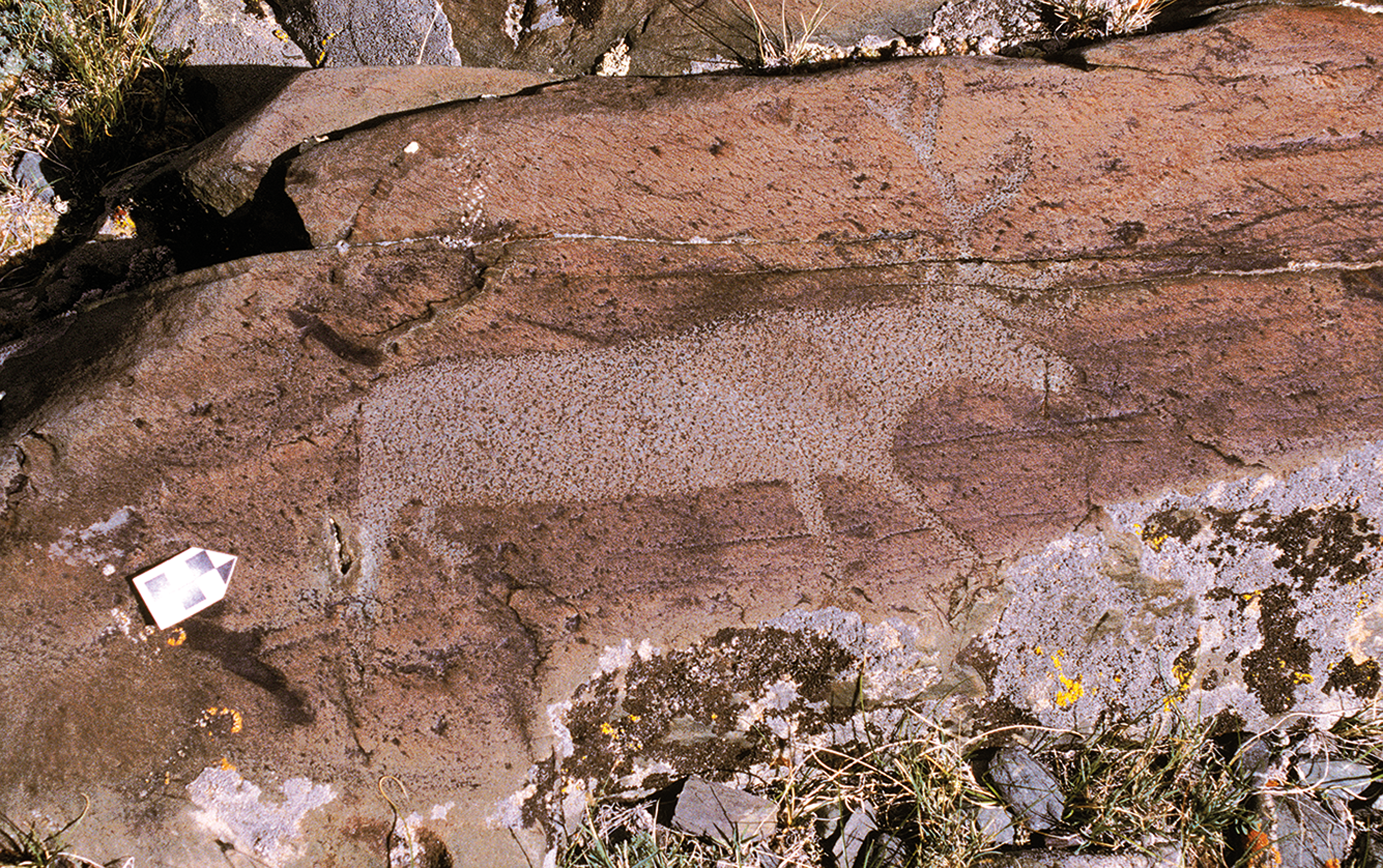
Figure 8. Elk walking right. Bronze Age. Baga Oigor complex, TS IV. (Photograph: Gary Tepfer.)
By the mid-Bronze Age, elk (as well as other animals) were frequently represented within the context of human activity: they had become embedded in the world contemporary hunters and gatherers saw and wished to reproduce on the surfaces of boulders and bedrock. This is exemplified by the scene on a small stone surface from the section BO IV. On the left side of the panel, an archer takes aim at a large elk (Fig. 9). On the right is the image of a wild horse, seemingly executed at the same time; but the pecking technique and white patina characterizing the ibex on the far right indicate that it was added by another artist at a much later date. Despite the damage to the stone, it is clear that the elk has the large body and full neck of a grown animal. Its huge rack, also, with two sharply defined forehead tines, indicates a mature bull. The small hunter is no longer clear, but his bow is visibly large enough to be composite and thus an indicator of a Bronze Age date (Jacobson-Tepfer Reference Jacobson-Tepfer2019). From the back of his waist hangs a long object that has reminded some observers of a tail, but which is really a kind of fur-tipped wand (daluur) seen frequently in the representations of Bronze Age hunters. This instrument is also carried to the present day by hunters in the mountains and is used to distract small prey such as marmots (personal observation).
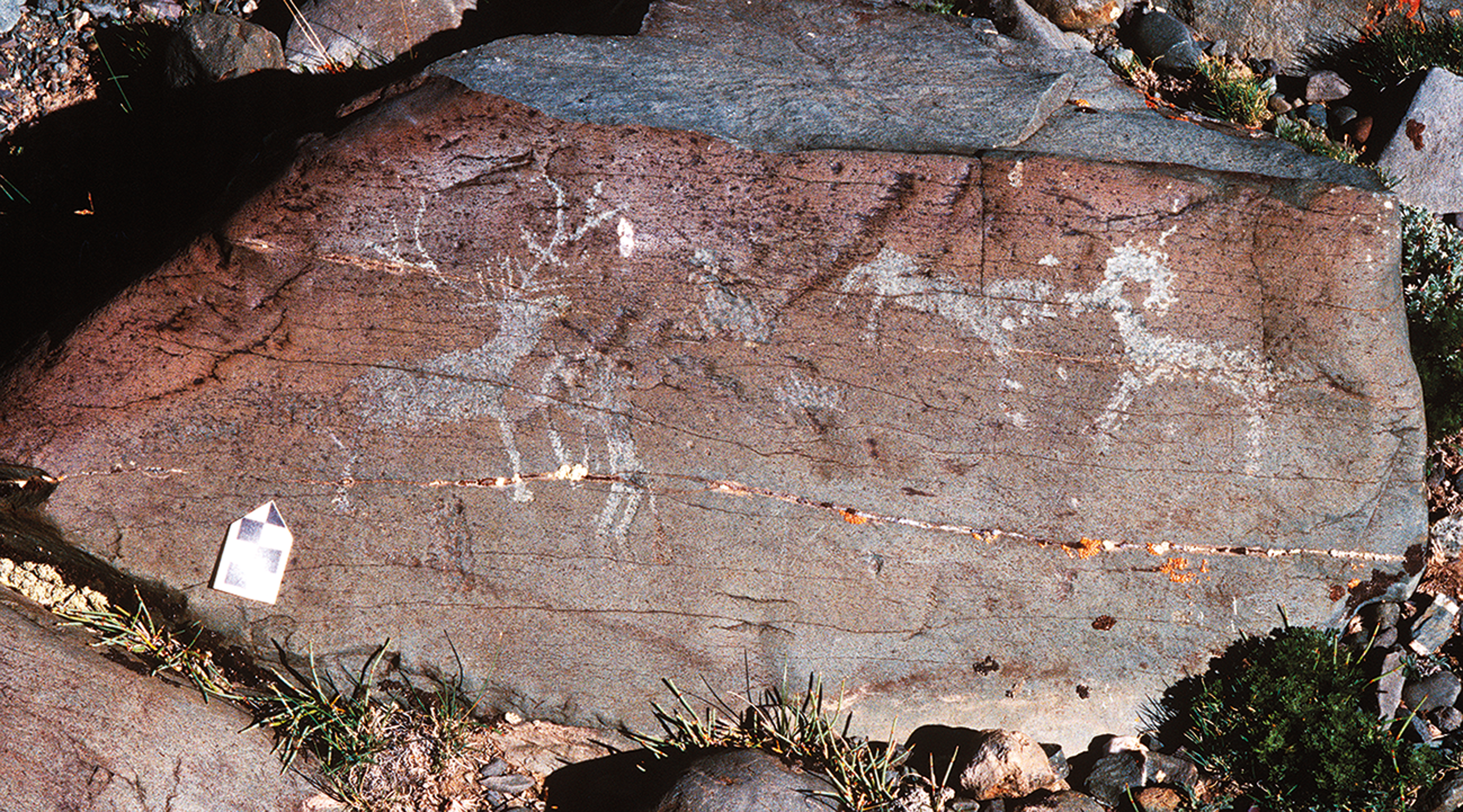
Figure 9. Archer and large elk. Bronze Age. Baga Oigor complex, BO IV. (Photograph: Gary Tepfer.)
Even though the hunter in the BO IV composition is represented as being unnaturally close to his prey, both the man and the animal are lifelike and unexaggerated. They reflect a real activity in a believable space; it is as if the artist were observing and recording an actual experience in his world. On another surface from the Tsagaan Gol complex (Fig. 10), a more active hunting composition unrolls on a damaged, vertical outcrop. On the left are three hunters, each carrying a small, composite bow, while before them two large elk—one a doe and the other a bull with the full throat of a mature animal—race to the right.

Figure 10. Two elk and three hunters on a vertical surface. Bronze Age. Tsagaan Gol complex, SK_E2. (Photograph: Gary Tepfer.)
In these two surfaces, the elk are very unlike the static animals of an earlier period. They raise their heads, as if in alarm, and in both surfaces they are represented as if truly observed in real life: as sentient, reactive animals.
In another panel from a large boulder in TS IV, a magnificent elk is accompanied by two smaller, beautifully rendered elk; all three carry large antlers and all have the powerful bodies of mature animals (Fig. 11). Around the elk are several attacking animals—either wolves or dogs—and in front of the large elk is a diminutive hunter. More important is the figure of a hunter on the far right, walking towards the surrounded elk. His composite bow and the long quiver case carried vertically at his waist indicate that this composition was executed in the full Bronze Age, before the advent of horse riding and the associated transformation of bow and quiver. The discrepancy in size between the largest elk and the realistic smaller ones suggests the intrusion, here, of a mythic recounting of a hunt (Jacobson-Tepfer Reference Jacobson-Tepfer2015); nonetheless, the animals are rendered as if observed in a state of nature.
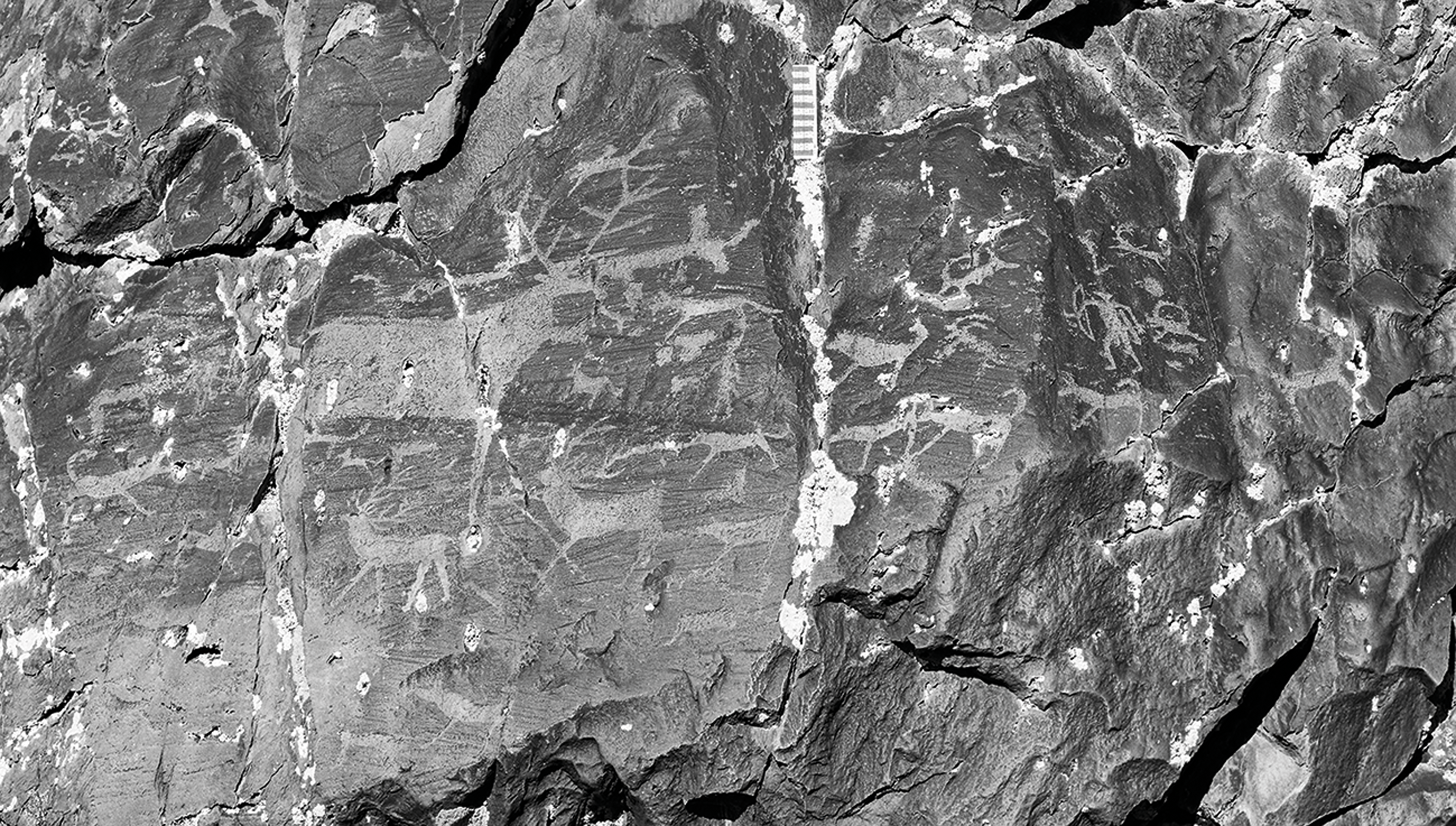
Figure 11. Elk surrounded by wolves or dogs; three hunters. Bronze Age. Baga Oigor complex, TS IV. (Photograph: Gary Tepfer.)
Beginning in the latter half of the Bronze Age, the representation of elk began to reflect a distinctive artistic sensibility on the part of the artist, rather than being an image intended to evoke the real animal faithfully, in its own, material world. This shift is apparent in a large panel from the Tsagaan Gol complex in which two hunters surround three elk (Fig. 12); they are visible in the centre of the composition, one partially lost under orange lichen. The animals are bracketed on either side by hunters carrying composite bows. The dress and weaponry of the men affirm the panel’s Bronze Age date; but the appearance of a hobbled horse at the far-right side of the panel (Fig. 13), tethered as if to be loaded with meat from the elk, indicates that the execution of the scene was late enough in the Bronze Age that horses were being used for load bearing, if not yet for riding.

Figure 12. Large elk hunt: the central elk are bracketed by hunters, left and right; on the far right is a single, hobbled horse. Late Bronze Age. Tsagaan Gol complex, SK_C5. (Photograph: Gary Tepfer.)
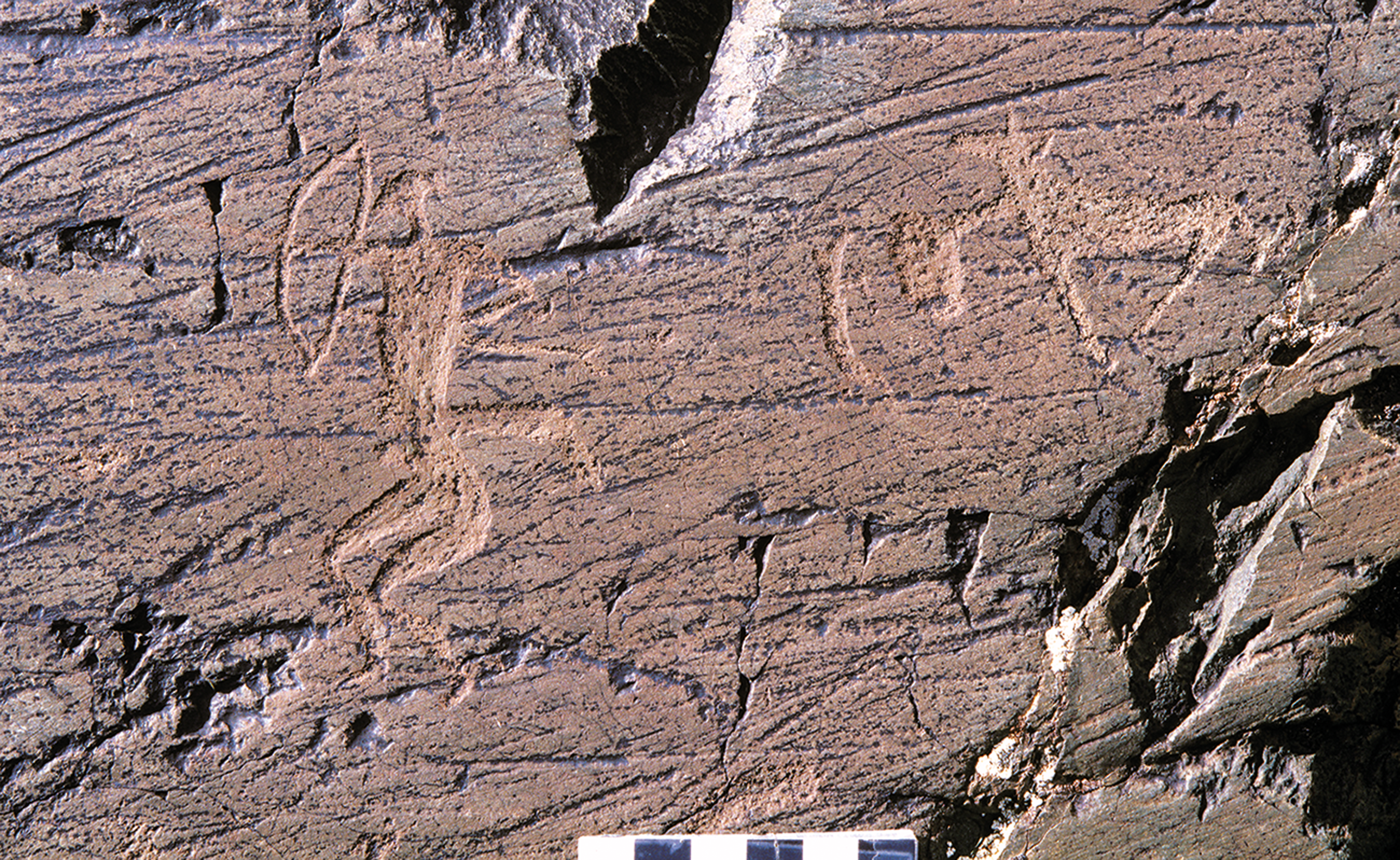
Figure 13. Detail of elk hunt in Figure 12: hunter on the far right and tethered horse. (Photograph: Gary Tepfer.)
In this narrative scene, it is the elk that centre and seize our attention. Their prancing legs and raised heads capture the alarm of living animals, their expression of fearful awareness of impending danger at the moment before flight. On the other hand, their bodies are more elegantly depicted than those of the heavier, realistic elk in earlier hunting scenes; they are rendered with a far greater sense of style than would be true of earlier elk imagery. In this respect, these elk point to a major shift in artistic sensibility at the end of the Bronze Age: where animals are increasingly shaped more by the artist’s creative vision than by a desire to replicate real animals with their actual physical character. This was part of a continuing process that accelerated towards the end of the Bronze Age, as representations of elk (and of other animals) were gradually re-shaped to project a more subjective, or stylized, idea of an animal divorced from its phenomenal being and increasingly rendered with reference to some other model.
A continuing shift from realism to stylization emerged first fitfully and then more steadily during the early and middle centuries of the first millennium bce—a period corresponding to the transition between the late Bronze and early Iron Ages. This does not mean that all elk images became highly stylized. They did not, but the instances of a return to naturalism became fewer; and the image of the elk was gradually transformed into something very different from the antlered animal so vividly depicted in the pre-Bronze and early Bronze Age imagery.
This process can be illustrated by a number of panels from the Baga Oigor complex. In a panel located high in the section TS I, two elk are being attacked by three wolves (Fig. 14). The larger elk’s antlers are huge, exaggerating the massive rack of a mature animal. The smaller elk has a commensurately smaller rack, suggesting a younger animal. This elk is fairly realistic in its body shape, but the larger elk is not: its neck is exaggeratedly long and downcurved, its withers strangely raised into a peak, and its head unnaturally elongated. Similar exaggerations are visible in the more beautifully pecked elk carved on a curved and glacier-scraped boulder in BO II (Fig. 15). In this case the flow of the animal’s large body is echoed in the wave-like antler tines; but its hind quarters and front legs are strangely reduced in size, just as its head is exaggeratedly elongated. The small hunters and other animals around the elk are themselves awkward creatures, although to judge from the re-patination of pecked areas they were seemingly executed at the same time. If that was the case, then we see another important shift: not only is the animal of an exaggerated and stylized elegance, but its new formulation seems to exist in another aesthetic realm than that of the ungainly hunters: the latter are mere appendages to the fine but unnatural elk.

Figure 14. Wolves attacking elk. Late Bronze Age. Baga Oigor complex, TS I. (Photograph: Gary Tepfer.)
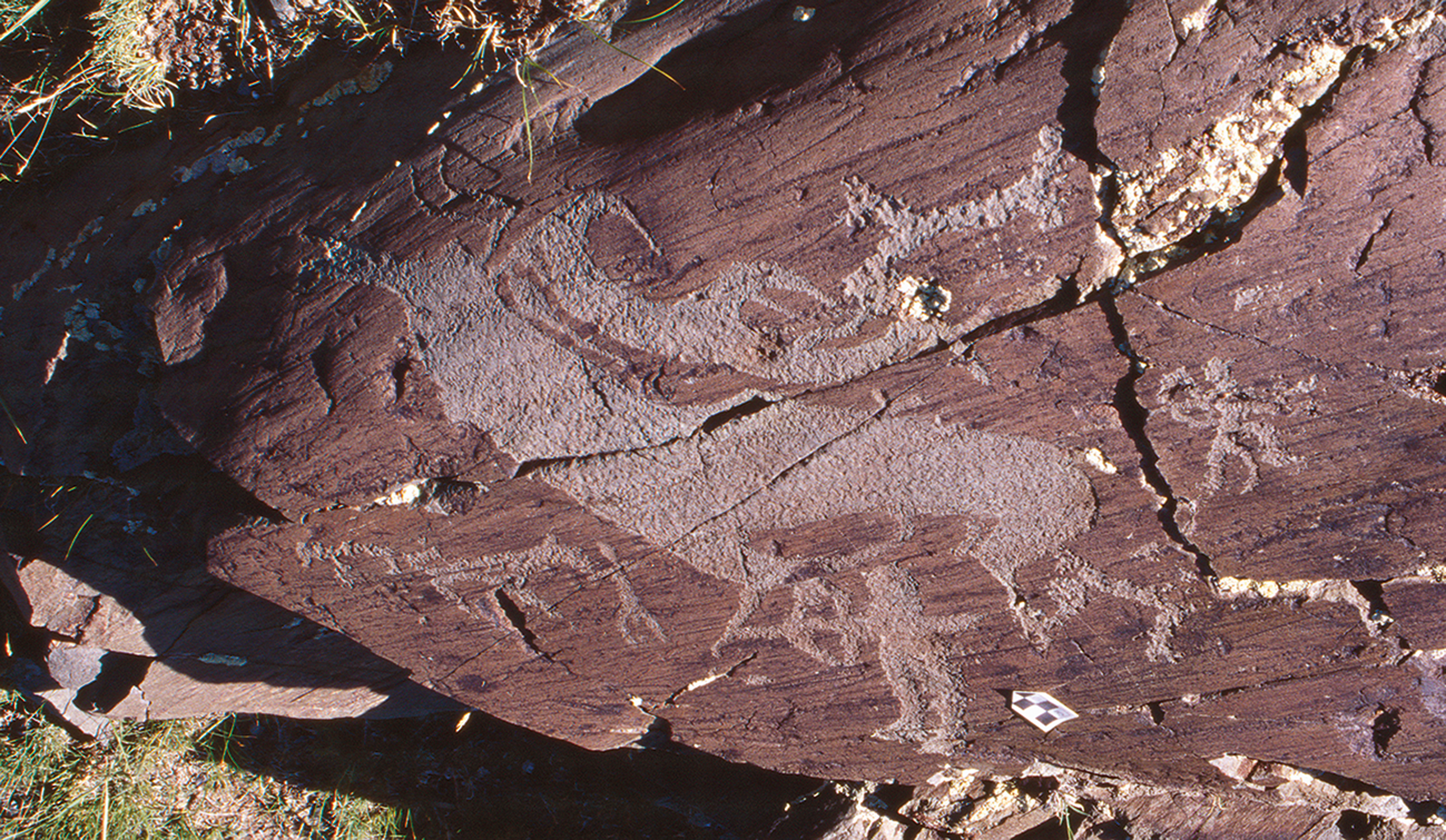
Figure 15. Large, stylized elk, and clumsy hunters. Late Bronze Age. Baga Oigor complex, BO II. (Photograph: Gary Tepfer.)
On a surface from the large complex of Tsagaan Gol, three images reveal the transformation of the animal image (and particularly that of the elk) in the transition from the Bronze Age to the Iron Age (Fig. 16). The elegant elk in the upper part of the panel is very like that in the panel from BO II, with elongated body and beautiful wave-like antlers. Its head, too, is unnaturally elongated; but here the elk’s body is much slenderer, and its legs are more articulated. The pecking of the animal has the transitional patina of an image executed in the late Bronze Age (Jacobson-Tepfer Reference Jacobson-Tepfer2020). This contrasts with the darker yak just below, turned at a 90° angle from the elk. That animal’s shape and patina indicate a full Bronze Age date. The third animal, a very light elk with almost invisible antlers, has the white patina of an image executed in the Turkic Period, sometime in the mid-first millennium of our era.
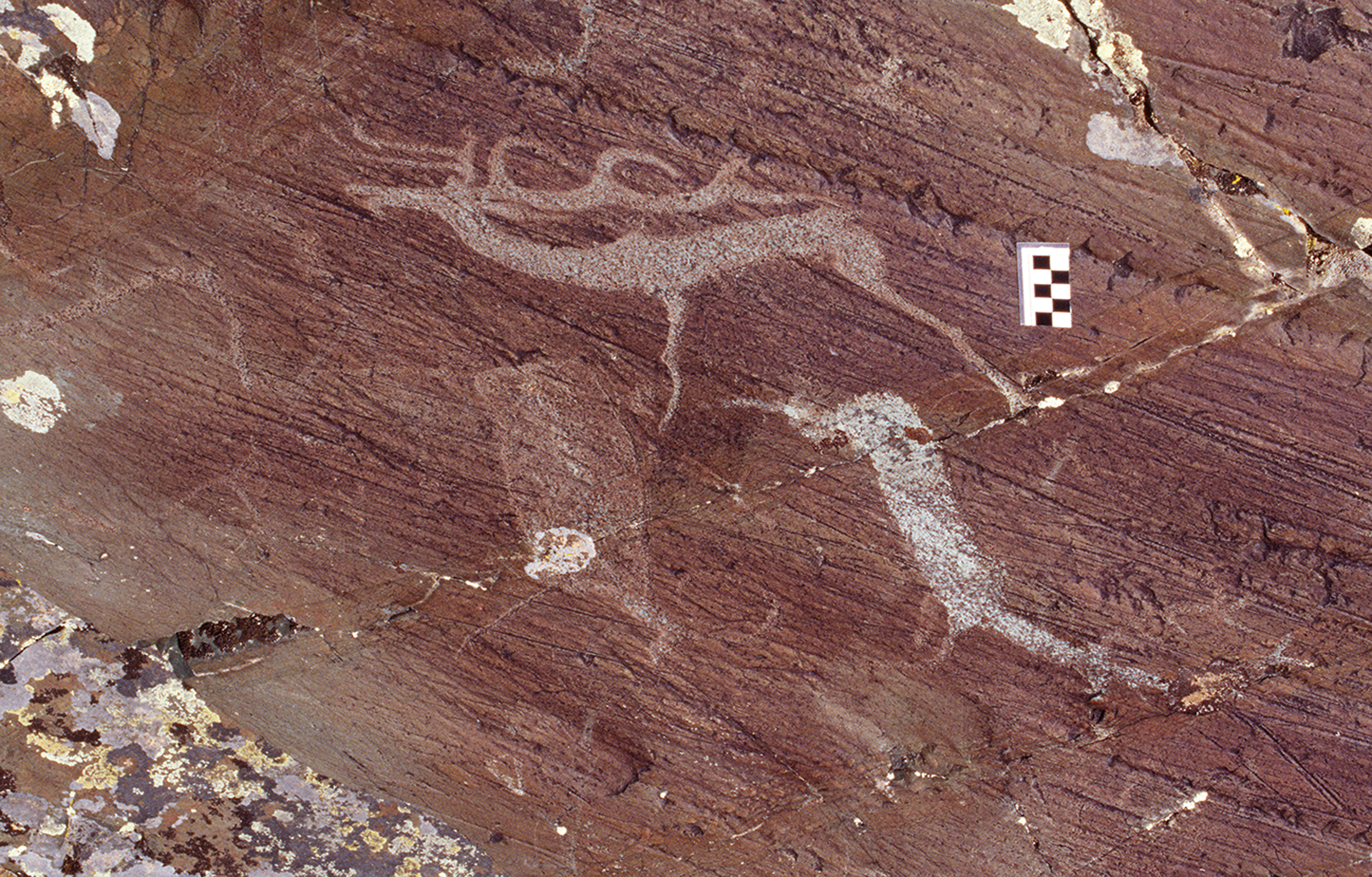
Figure 16. Three comparative images: yak, Bronze Age; elegant elk, late Bronze Age; and light-coloured elk from the Turkic Period. Tsagaan Gol complex, SK_F4. (Photograph: Gary Tepfer.)
These exaggerated antlers and elongated bodies—thoroughly unlike the heavy body of a real elk—appear increasingly in rock art of the late Bronze Age. Examples can be found on a large boulder from BO III on which are depicted several scenes of animal predation; in each scene, the elk is represented with a long and elegant body as well as with large, if varied antlers (Fig. 17).

Figure 17. Wolves predating on an elk. Detail of a larger predation panel. Late Bronze–early Iron Age. Baga Oigor complex, BO III. (Photograph: Gary Tepfer.)
A cruder panel from the Tsagaan Gol complex includes more information to help us date the appearance of these elongated, stylized elk (Fig. 18). In this case the elk is being followed by a hunter holding a clearly depicted recurve bow—a sure sign of the early Iron Age. In another instance of a hunt, from TS IV, the head of the elk has been lost in the spalling stone. Here, however, the hunter rides a camel—another clear indication of a date at the end of the Bronze Age—and draws a recurve bow (Fig. 19).

Figure 18. Hunter with recurve bow stalking a stylized elk. Early Iron Age. Tsagaan Gol complex, SK_H4. (Photograph: Gary Tepfer.)

Figure 19. Camel rider with recurve bow aiming at a stylized elk; detail from a larger composition on a massive boulder. Early Iron Age. Baga Oigor complex, TS IV. (Photograph: Gary Tepfer.)
The juxtaposition of image types—relatively realistic and more stylized—illustrates the extent to which artists were turning from the reproduction of the real world and increasingly investing their imagery with references very different from that indicated in pre-Bronze Age and Bronze Age panels. The fact that these variations involved deliberate and individual choice is reflected in paired panels from one Tsagaan Gol site, SK_K4, with a great variety of large compositions. On a vertical surface at the west end of the cliff, an artist pecked out a scene of several elk, male and female, being preyed on by a pack of wolves (Fig. 20). Despite a certain awkwardness in their postures, the elk are realistic. The shape of their bodies and the branching of their antlers are thoroughly reminiscent of the real animal. Directly below this panel is another, this also covered with images of male and female elk as well as ibex, and two small, barely visible, human figures (Fig. 21). Here, however, the elk are very different from those in the upper panel: their bodies are elongated with unnaturally arched necks and pulled-up hips, their antlers flow back over their spines in a manner reminiscent of wings, and the head of the central animal is small and elongated. The upper panel was certainly executed in the Bronze Age, while the handling of all the stylized animals in the lower panel indicates an end-Bronze Age date. In this case, it is quite obvious that the artist of the lower panel had an example of a more realistic rendition above but chose to ignore it. In other words, in the rendering of all the animals, elk and ibex, the artist of this lower panel was focused more on the stylized idea of an elk and not on the animal in its natural world.
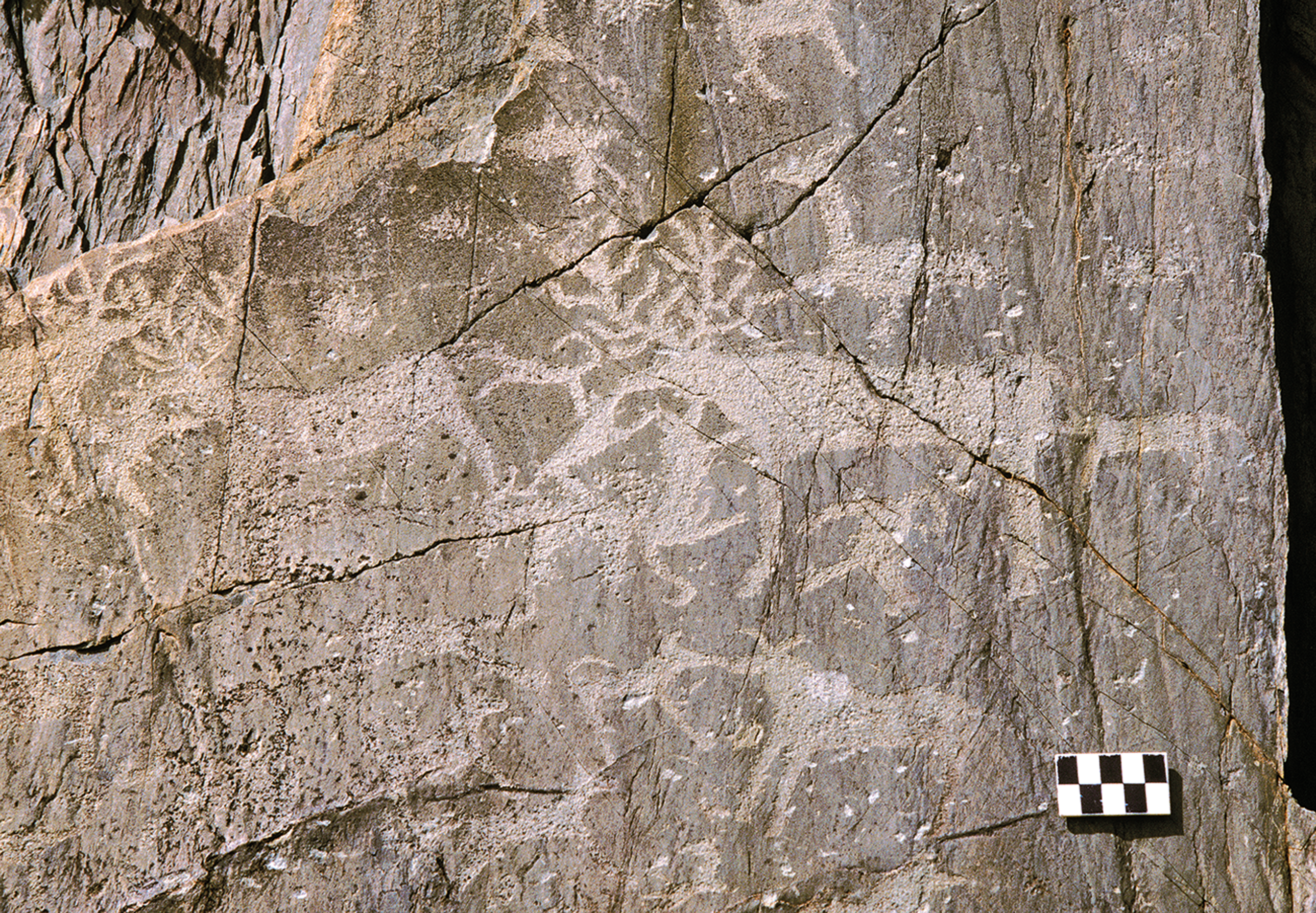
Figure 20. Wolves attacking large elk; one of two panels arranged on a vertical wall. Bronze Age. Tsagaan Gol complex, SK_K4. (Photograph: Gary Tepfer.)
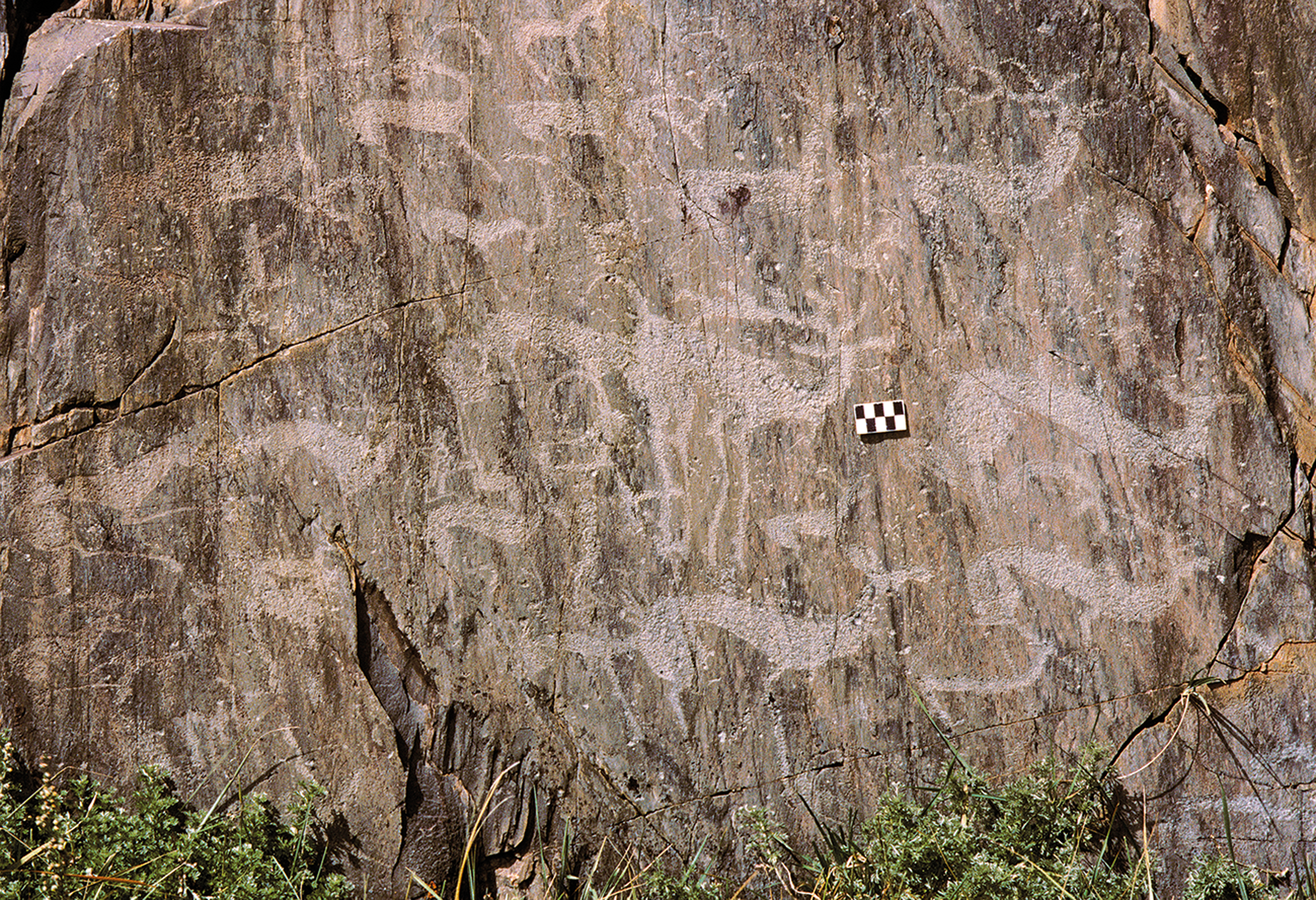
Figure 21. Elk and other animals, executed in the Arzhan style; lower panel on a vertical wall. Late Bronze Age. Tsagaan Gol complex, SK_K4. (Photograph: Gary Tepfer.)
The animals depicted in the lower panel (Fig. 21) are shaped in a style that has come to be called Arzhan, after the animals executed in bronze and gold found in the two late Bronze Age burials, Arzhan 1 and 2 (Chugunov et al. Reference Chugunov, Parzinger and Nagler2010; Gryaznov Reference Gryaznov1980). Located in the Sayan Mountains just to the north of our focus region of Bayan Ölgiy aimag, those burials have become a touchstone of style and subject matter in the decorative arts of that period. Arzhan 1 was a huge burial structure in the shape of a great spoked wheel. Not long after the mound was closed, the burial chambers were plundered by robbers, the great wooden structure was burned, and the ruined mound and burials were essentially lost for over 2500 years. Despite that extensive damage, enough materials in bronze survived to allow Michael Gryaznov, the burial’s excavator, to date Arzhan 1 to the ninth century bce, while more recent studies have lowered that date to the boundary between the ninth and eighth centuries (Gryaznov Reference Gryaznov1980; Zaitseva et al.2004 Reference Zaitseva, Vasiliev and Marsadolov1998; ; see Jacobson-Tepfer Reference Jacobson-Tepfer2015). Bronze pole-tops recovered from the burial are topped with argali figures rendered in a distinctive style: the animals’ bodies are contracted as if perched on a narrow ridge, the musculature of shoulders and hips is pronounced, the head transformed into a series of circular references echoed in the great, heavy horns. A fragment of a broken deer stone said by the excavator to be found in the mound of the burial includes elk and boars presented in a similarly constricted, stylized fashion, with eyes that are cellular in appearance as if they were copied directly from cast metal models (Fig. 22) (see Kilunovskaya et al. Reference Kilunovskaya, Semenov, Semenov, Chadamba, Jacobson-Tepfer and Novozhenov2020).
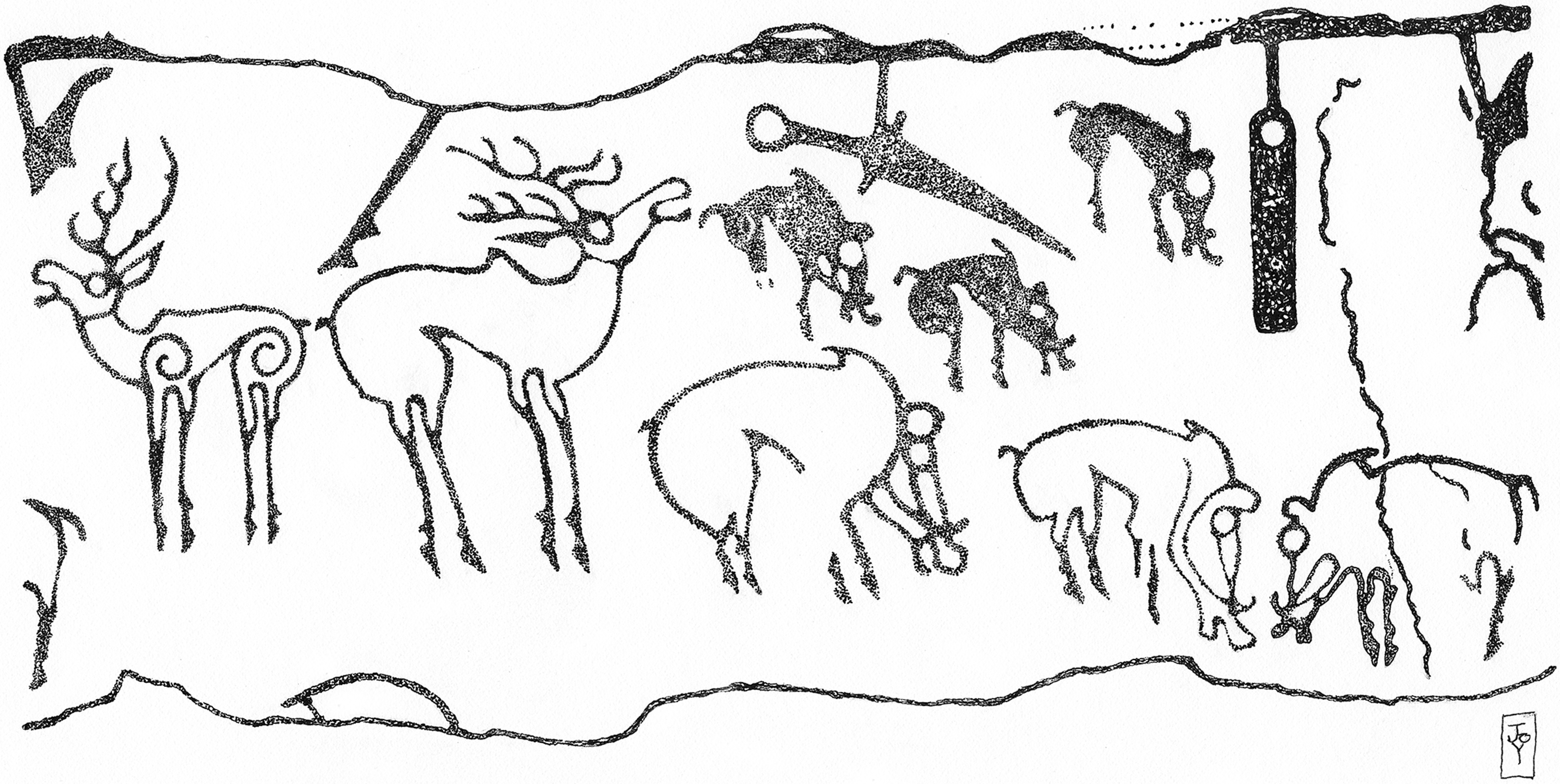
Figure 22. Fragment of a deer stone found in the mound of Arzhan 1. Petroglyph. (Gryaznov Reference Gryaznov1980; drawing by L.-M. Kara.)
Even more significant in establishing the concept of an Arzhan style were the finds from the intact burial of Arzhan 2 (Chugunov et al. Reference Chugunov, Parzinger and Nagler2010). Within a large mound including several plundered burials and a horse burial with 16 sacrificed animals was found a single wooden chamber that had not been breached by ancient robbers. It included the carefully arranged bodies of a man and woman surrounded by thousands of gold plaques that had originally decorated the elaborate clothing in which the dead had been laid to rest. This burial, referred to by its excavators as #5, has been confidently dated to the seventh or late seventh century bce (Zaitseva et al. Reference Zaitseva, Chugunov and Dergachev2004). Many of the animals depicted in the clothing plaques and other decorative ornaments have the same stylized bodies and heads as the images in the lower panel from the cliff in SK_K4 (Fig. 21). One of the finest examples is offered by a crown ornament associated with the man’s headgear (Fig. 23). Made of heavy sheet gold, the image of a standing bull elk looks as if it could have served as a model for the rock pecked images in Figure 21.

Figure 23. Standing bull elk, device for a headdress for the male buried in Arzhan 2. Gold. Late Bronze Age. (Drawing: L.-M. Kara.)
The Arzhan burials give us a certain time frame indicating that, by the eighth century bce, what is here referred to as the Arzhan style began to appear ubiquitously in rock art. It emerges in the form of individual images, most particularly elk, boars, and horses, as well as in groups of images strangely dissociated from each other. This shift is apparent within many panels from such complexes as Khölstöötiin Gol (Figs 24, 25), Baga Oigor (Fig. 26) and Tsagaan Gol (Jacobson-Tepfer et al. Reference Jacobson-Tepfer, Kubarev and Tseveendorj2006, vol. 2, pls 561, 562).
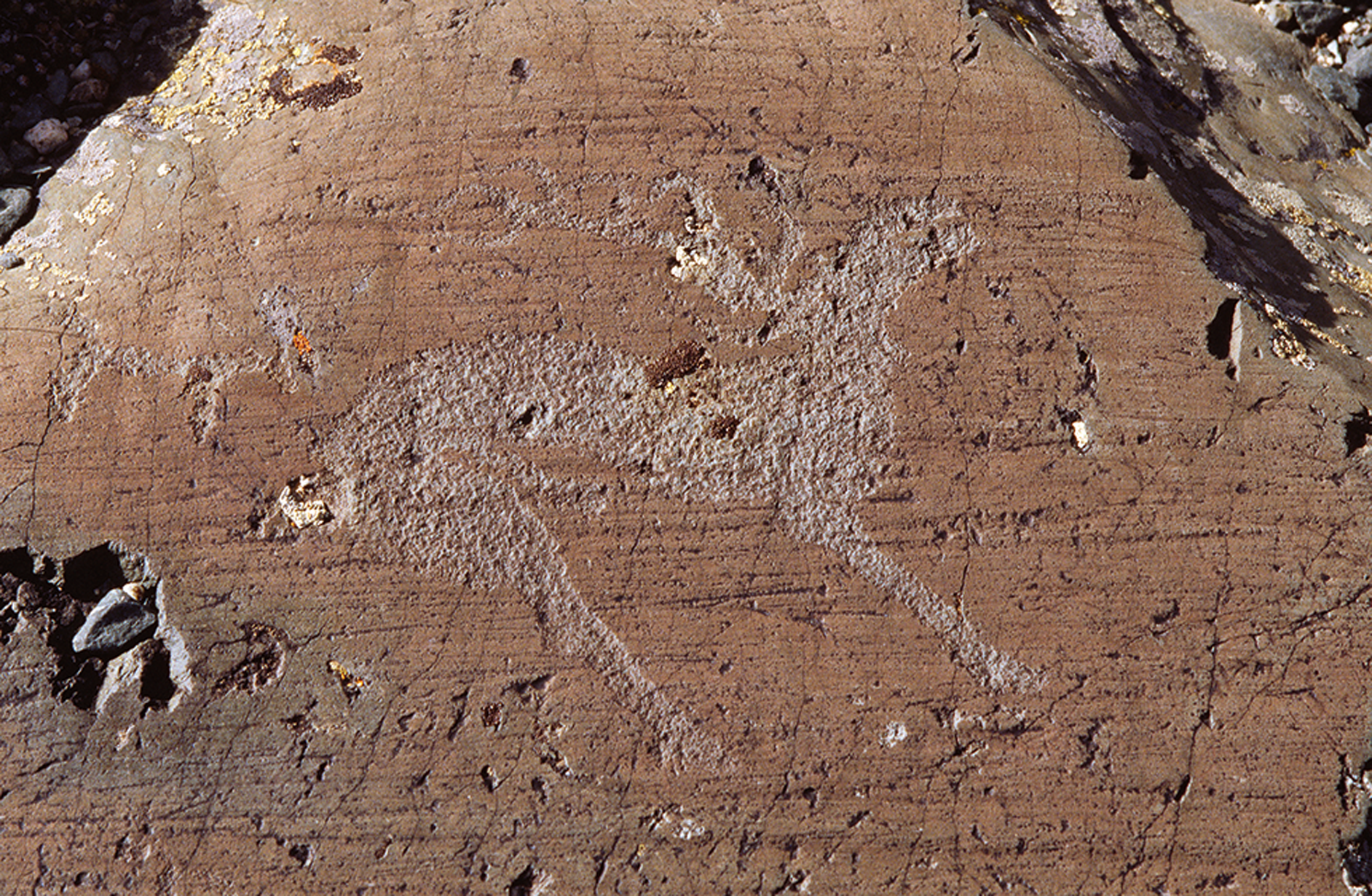
Figure 24. Bull elk executed in Arzhan style. Late Bronze Age. Khöltsöötiin Gol complex. (Photograph: Gary Tepfer.)
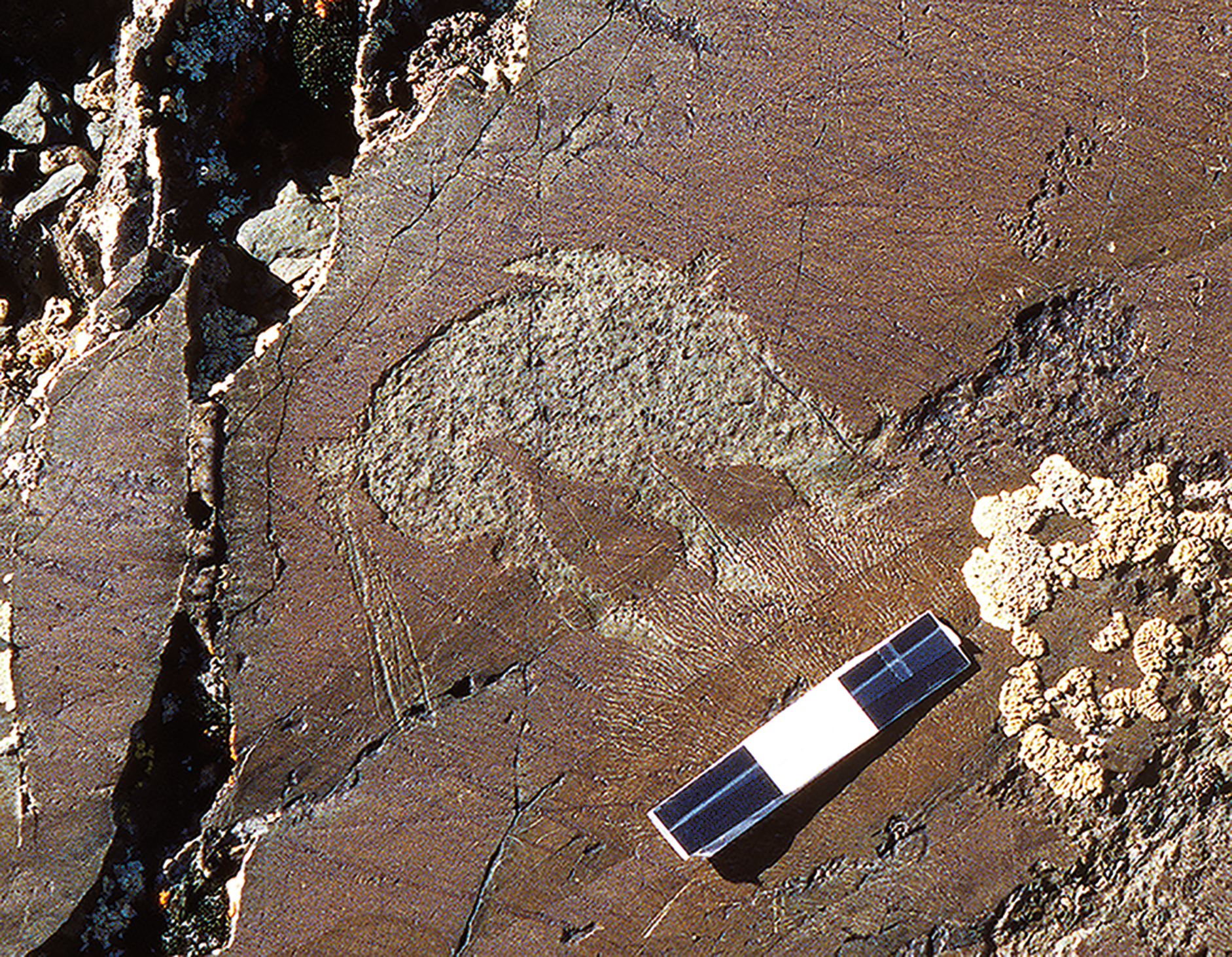
Figure 25. Boar executed in Arzhan style. Late Bronze Age. Khöltsöötiin Gol complex. (Photograph: Gary Tepfer.)
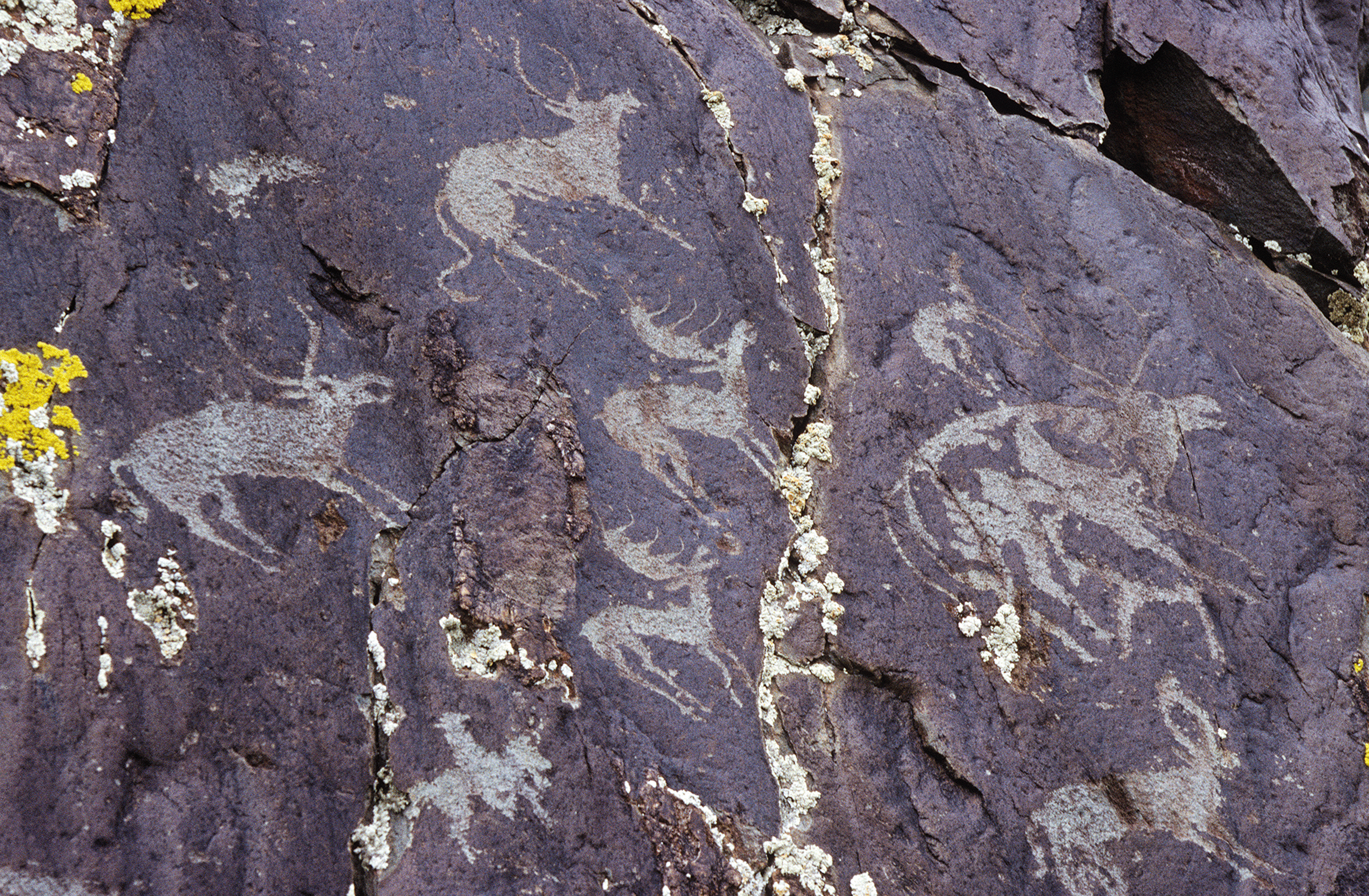
Figure 26. Central section of a large surface with stylized yaks and elk in Arzhan style, a large yak with interior images, and a small rider. Late Bronze Age. Baga Oigor complex, BO III. (Photograph: Gary Tepfer.)
Unusually vivid examples of the expression of the Arzhan style in rock art are found on a large boulder in BO III (Fig. 26); the images include elk, yaks and a small rider. The elk, in particular, bear immediate comparison with those in metal found at Arzhan 2 and with the imagery on fragments of deer stones found in the mounds of both Arzhan 1 (Fig. 22) and Arzhan 2 (Chugunov et al. Reference Chugunov, Parzinger and Nagler2010).
In addition to the Arzhan style, there are other examples of the stylization of elk imagery in rock art at the end of the Bronze Age. In these, however, the pictorial reference is to the metal work associated with the late Bronze–early Iron Age Tagar culture centred in the upper Yenisei Basin (Sovetova Reference Sovetova2005). Tagar was one of several Siberian Scythian groups in the mid to late first millennium bce, related to but distinguishable from the Pazyryk culture centred in the Russian Altai (Bokovenko Reference Bokovenko2006; Dirksen et al. Reference Dirksen, van Geel and Koulkova2007; Linduff & Rubinson Reference Linduff and Rubinson2022). There are enough images in Bayan Ölgiy rock art reflective of Tagar riders and pictorial taste to indicate that there had to have been a strong Tagar presence in northern Bayan Ölgiy in the middle of the first millennium bce. To judge from panels in the Tsagaan Gol complex, that high river valley was for a time a centre of Tagar culture (cf. MAIC: TG_04132). One of the most impressive examples of the Tagar pictorial tradition is found in a horizontal panel high above the left bank of Tsagaan Gol (Fig. 27). On the large, damaged surface are three superbly executed elk—two bull elk and one doe. All three animals were pecked with the configuration of images replicated in Tagar period bronze plaques (Zavitukhina Reference Zavitukhina1983); even the manner of shaping the animals’ hind quarters and shoulders mimics the three-dimensionality of cast or carved prototypes.
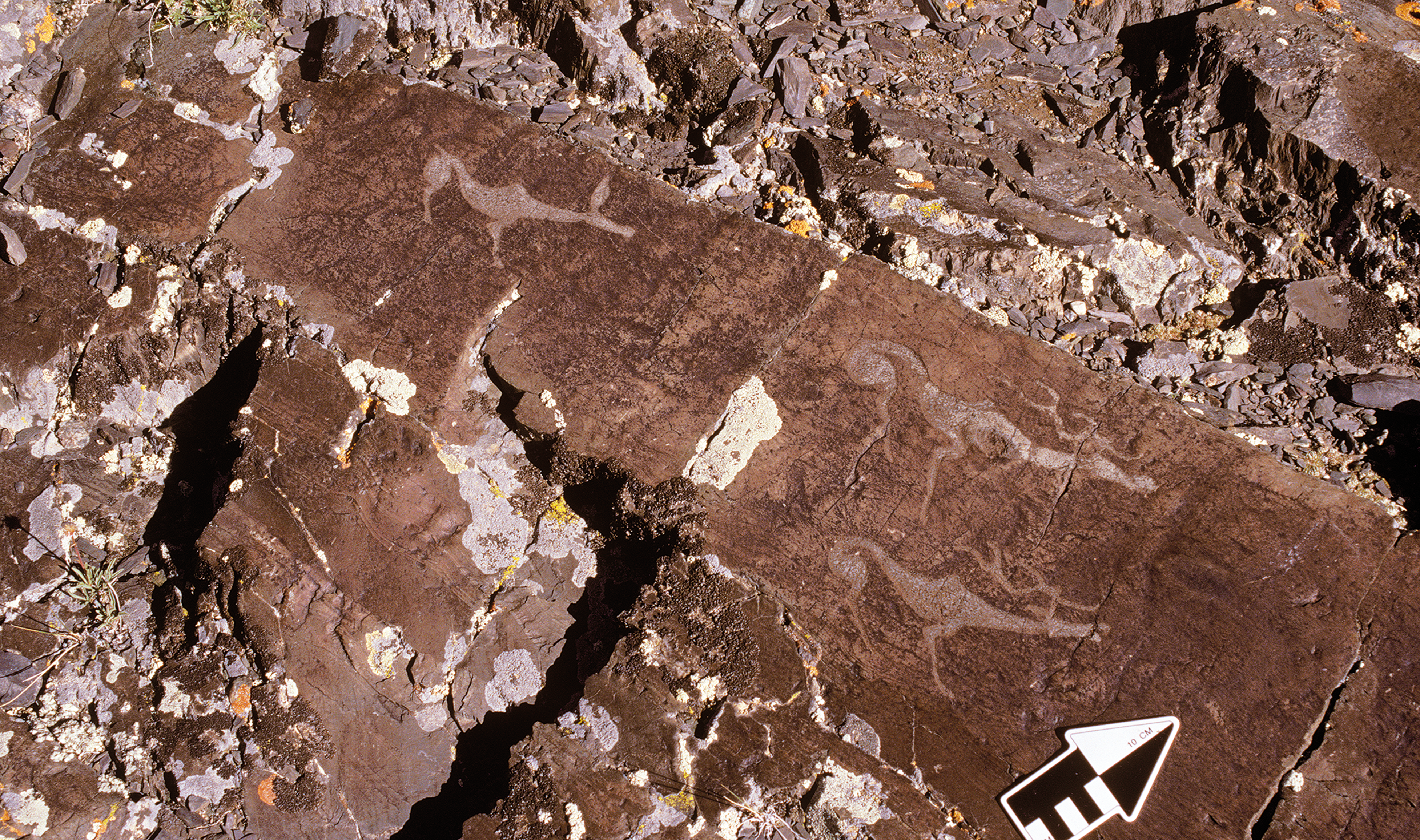
Figure 27. Bedrock slab with images of three elk. Late Bronze-early Iron Age. Tsagaan Gol complex, TS_E7. (Photograph: Gary Tepfer.)
A third stylization of the elk image emerges in the so-called deer stone tradition, particularly that associated with what has been referred to as the Mongolian style (Jacobson-Tepfer Reference Jacobson-Tepfer2015; Savinov Reference Savinov1994; cf. Jacobson-Tepfer Reference Jacobson-Tepfer2023). That image type (Fig. 28), with elaborately flowing antlers similar to the stag on the TS IV boulder (Fig. 3), is most probably based on tattoo and fabric arts and is closest in derivation to a Pazyryk style.
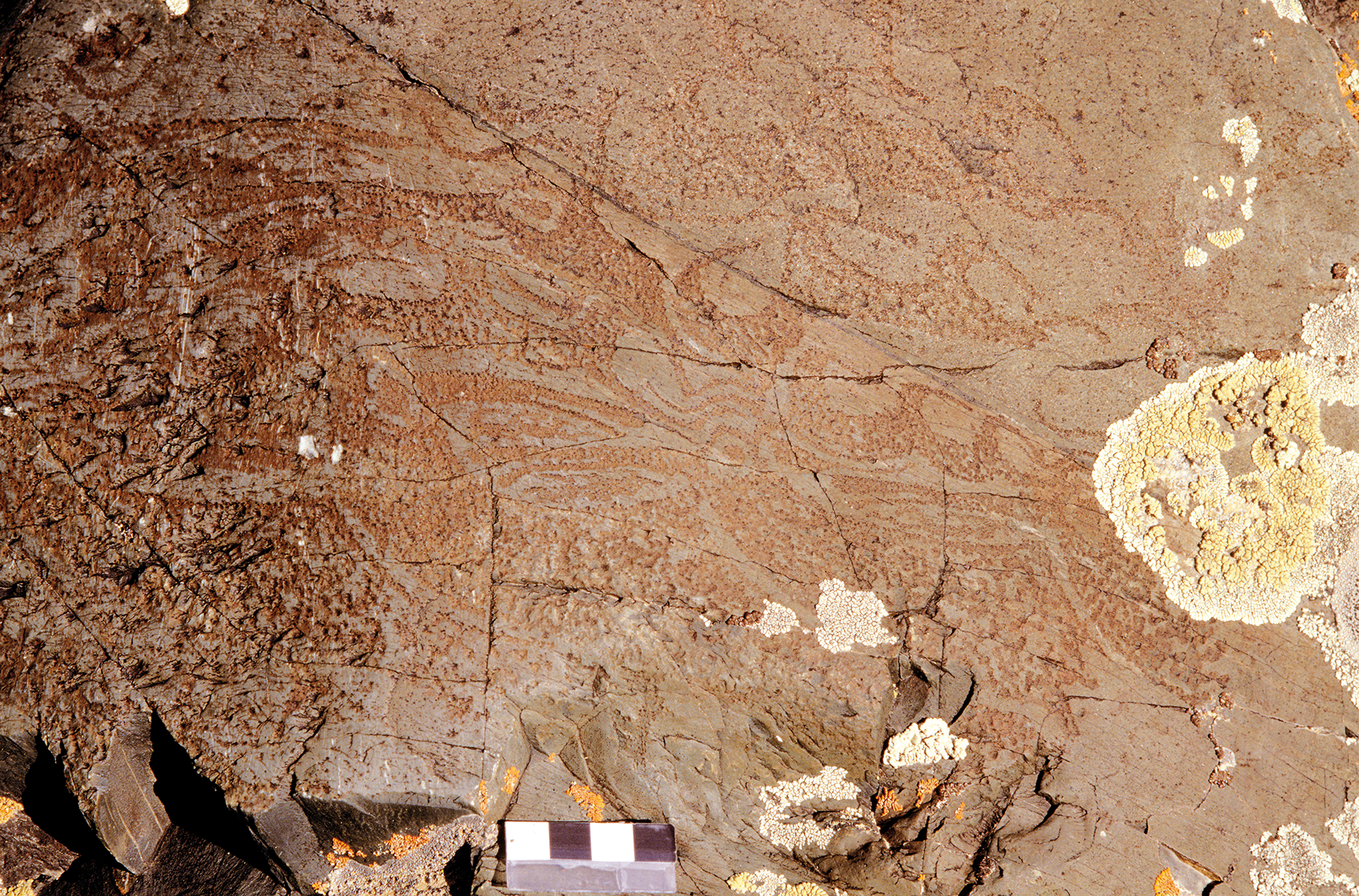
Figure 28. Detail of a panel with highly stylized elk, executed in a manner recalling tattoo art. Tsagaan Gol complex, TS_B6. (Photograph: Gary Tepfer.)
Within the imagery from the Arzhan 1 deer stone fragment (Fig. 22), the marks of a new and pronounced divorce from reality are the elks’ dangling legs and feet and the exaggerated bends in their necks and withers. The boars have the same exaggeration of body and legs and a similarly rigid stance. Some observers have argued that these are the images of dead animals, their bodies stretched out in a kind of rigor mortis. One could also argue that the elks’ raised heads and occasionally open mouths indicate the bugling of an elk in rut. However, neither of those explanations may be as significant as the pictorial reference of that imagery and the imagery in a Tagar style: carved and cast plaques and pole-tops rather than the animal seen in a state of nature.
Handsome as are the images of elk reflective of Arzhan, Tagar and Pazyryk portable arts, all have been deliberately transformed from reflections of real, physical beasts into emblems: that is, into images or objects intended to symbolize an idea, or perhaps a rank, a clan, or some other socially significant identification or affiliation (Jacobson-Tepfer Reference Jacobson-Tepfer2000). As such, the imagery implicates a widening gap between the natural world and the artistic response to it, on both the individual and social levels.
The radical de-naturing of the elk image indicates that earlier frames of reference joining the individual to the phenomenal world had weakened and were falling away, replaced by concerns with social identity and status. Whether the stylistic changes began with tattooed or fabric art, with the fabrication of portable items, or rather with changes in style within the rock-art tradition itself remains uncertain. There is considerable evidence to indicate that in all cases, imagery in rock art followed on the development of portable models; but that investigation goes beyond this discussion and must be set aside for now. The question, here, is why that extreme stylization happened and whether it is possible to identify spheres of causation within a larger context? In fact, there are several underlying dynamics that led to the transformations discussed above. They may be divided into three levels of reference: first, the larger palaeoenvironmental context; second, the extended social and political responses to that larger context; and three, more immediate forces that catalysed perceptible social change and resulting individual actions.
The first and most overarching of these contexts must be that of environmental change (Fig. 5). Throughout the second millennium bce, the Eurasian steppe was slowly reverting to the cooler and drier conditions that would mark off the late Holocene from the mid-Holocene (An et al. Reference An, Chen and Barton2008; Klinge & Sauer Reference Klinge and Sauer2019; Rudaya et al. Reference Rudaya, Tarasov and Dorofeyuk2009; Zhang & Feng Reference Zhang and Feng2018). Within that shift, forests continued to recede back from their full expanse in the mid-Holocene, increasingly giving way to dry steppe in the lowlands (Gunin et al. Reference Gunin, Vostokova, Korofeyuk, Tarasev and Black1999; Panyushkina Reference Panyushkina2012). This transformation of the vegetation regime affected not just the mountainous regions, but also the extended steppe regions to east, south and west of the Altai–Sayan uplift. These changes probably necessitated hunters moving higher in the mountains for good hunting grounds and herders driving their flocks further for new pasture. It is certainly these developments that are reflected in the numerous Bronze Age scenes of families trudging with their animals, their yaks laden with household goods, family members and portable dwellings as they moved from lower to higher pastures for the warmer months of the year (e.g. Fig. 29). It is also reflected in the increasing elevations at which appear rock-art concentrations of the Bronze and Late Bronze Ages in the Baga Oigor valley (Jacobson-Tepfer et al. Reference Jacobson-Tepfer, Meacham and Tepfer2010, 3:33–3:39). The curious, gradual separation of artistic expression glimpsed in the de-naturing of the animal image was thus cradled within the transformation of a regional vegetation regime that slowly impacted the faunal world. The late period within this environmental change extended over what Panyushkina and colleagues have described as three climatic shifts within the space of approximately 700 years (Panyushkina Reference Panyushkina2012). The increasing expansion of dry steppe and retreat of forest cover through the first millennium bce must have had a profound impact on forest-dependent animal populations, including above all elk and bear, forcing them to withdraw further west and northwest where coniferous and deciduous forests have persisted up into the present day.

Figure 29. Caravan scene with woman leading a yak on which sits another figure; two hunters with bows and quivers and wild animals. Late Bronze Age. Tsagaan Gol complex, TG_04132. (Photograph: Gary Tepfer.)
That extensive environmental transition underlay the second significant context: that of social and political change. Developing vertical transhumance in response to an evolving climate accelerated during the first centuries of the first millennium bce and gradually evolved into a more decisive semi-nomadic pastoralism involving larger groups. This is particularly evident in the increasing size and extended distribution of burial grounds associated with the Siberian Scythians known as the Pazyryks. Within the Russian Altai, these cemeteries include, among others, Tuekta in the lower Ursul valley (Rudenko Reference Rudenko1960), Bashadar in the lower Karakol valley (Rudenko Reference Rudenko1960), Pazyryk in the Ulagan valley (Rudenko Reference Rudenko and Thompson1970; Linduff & Rubinson Reference Linduff and Rubinson2022), Akh-Alakha on the Ukok plateau (Polos’mak Reference Polos’mak2001), Ulandryk and Iustyd in the Chuya steppe and many others in the Kosh-Agach region (Bourgeois et al. Reference Bourgeois, Mikkelsen and van Hoof1999; Gheyle Reference Gheyle2009; Kubarev 1987; 1991; Reference Kubarev1992; Ochir-Koryaeva Reference Ochir-Goryaeva2017). On the Mongolian side of the mountain ridge, extended cemeteries of the same period appear within many river valleys (Parzinger et al. Reference Parzinger, Molodin and Tseveendorzh2009; Törbat et al. Reference Törbat, Bayar and Tseveendorzh2009a), and on the shores of Khoton, Khurgan, and Dayan nuur (lakes) (Törbat et al. Reference Törbat, Giscard and Batsükh2009b). While elite burials, such as Arzhan 1 and 2 and Tuekta 1, have attracted the most attention, there were far more burials associated with commoners. Most included horse sacrifices as well as carved ornaments, frequently covered by gold foil (Kubarev 1987; Reference Kubarev1991; Turbat & Batsukh Reference Turbat and Batsukh2015). They were, in other words, modest replications of the rich burials at Tuekta and in the Ulagan valley.
Most importantly, these cemeteries were the sign of an expanding, horse-dependent nomadic culture that appeared in the transition between the late Bronze and early Iron Ages and survived until the end of the first millennium bce (Taylor Reference Taylor2024). This culture has been fittingly referred to as Siberian Scythian (Panyushkina Reference Panyushkina2012), since by social characteristics and artistic expression the groups included within this rubric emerged out of the Sayan–Altai region and spread south and west as far as eastern Europe, where they became known as the Scythians, centred on the north and east shores of the Black Sea. At the same time, the social restlessness evident in the distribution of large cemeteries across the Altai uplift may also have distantly reflected the unsettled movement of populations in the vast steppe lands of present-day Mongolia during the second half of the first millennium bce, and their increasing conflict with the northern Chinese states (Jacobson-Tepfer Reference Jacobson-Tepfer2023).
The third and most significant cultural dynamic underlying the radical transformation of elk imagery in the late Bronze Age was the widespread emergence of horse dependency. Earlier, during the latter second millennium bce, the herders of the Altai and Sayan regions seem to have adopted the use of wild horses for load bearing and, perhaps, for traction, but not for riding. When images of riders do appear in the late Bronze Age, they are mounted on horses of a gracile body type, and they are executed with the same concern for realism as were images of elk and other animals (Fig. 30). In those images there is a similar naturalism, an easy reflection of the real world of animals. By contrast, in the case of imagery of riders marked by weaponry, clothing and the handling of animals as being of the early Iron Age, their mounts display a stylization very like that we see in contemporary imagery of elk and boars as well as in the gold and bronze plaques found in burials of that period (Fig. 31).
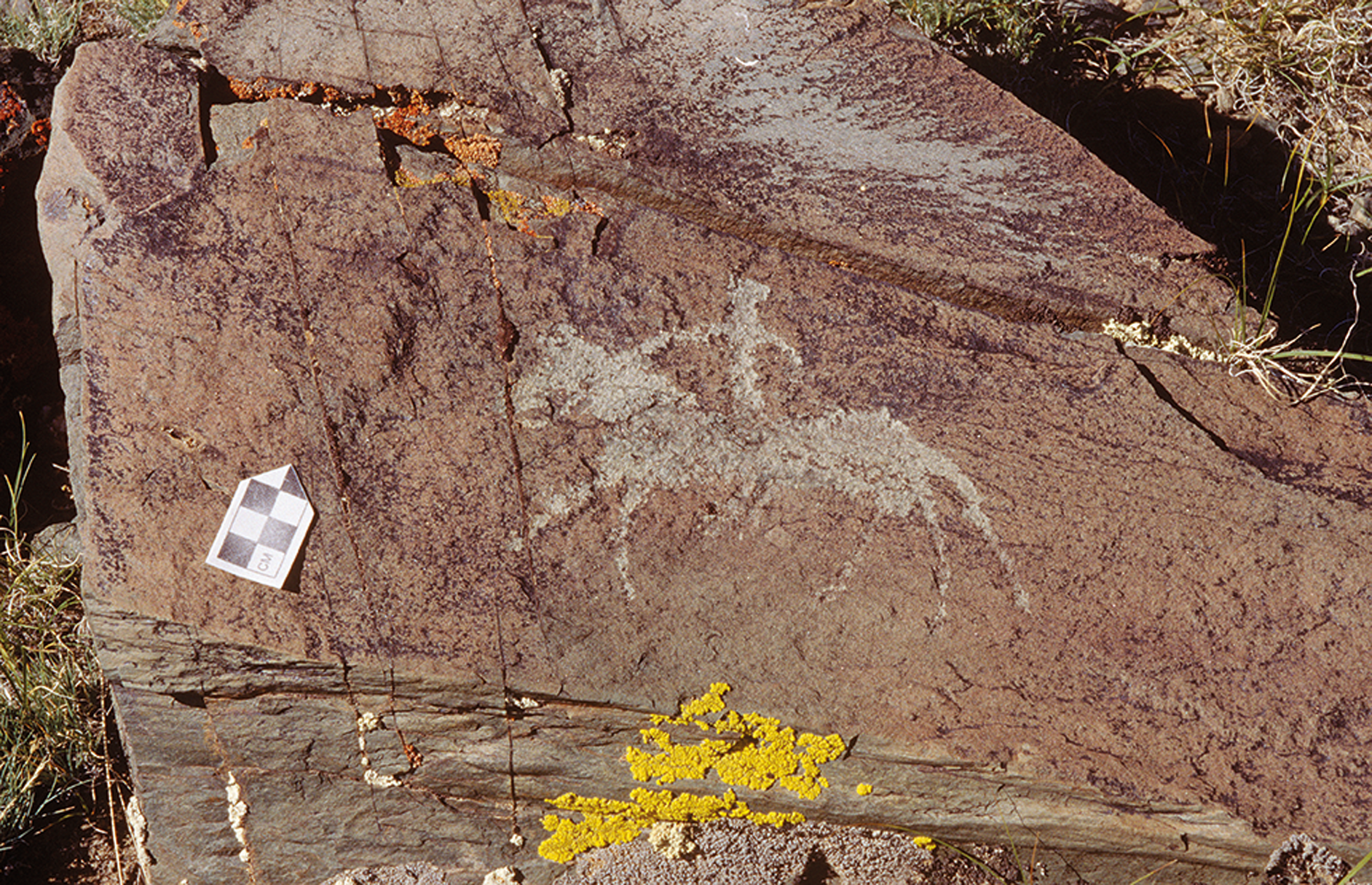
Figure 30. Rider. Late Bronze Age. Baga Oigor complex, TS IV. (Photograph: Gary Tepfer.)
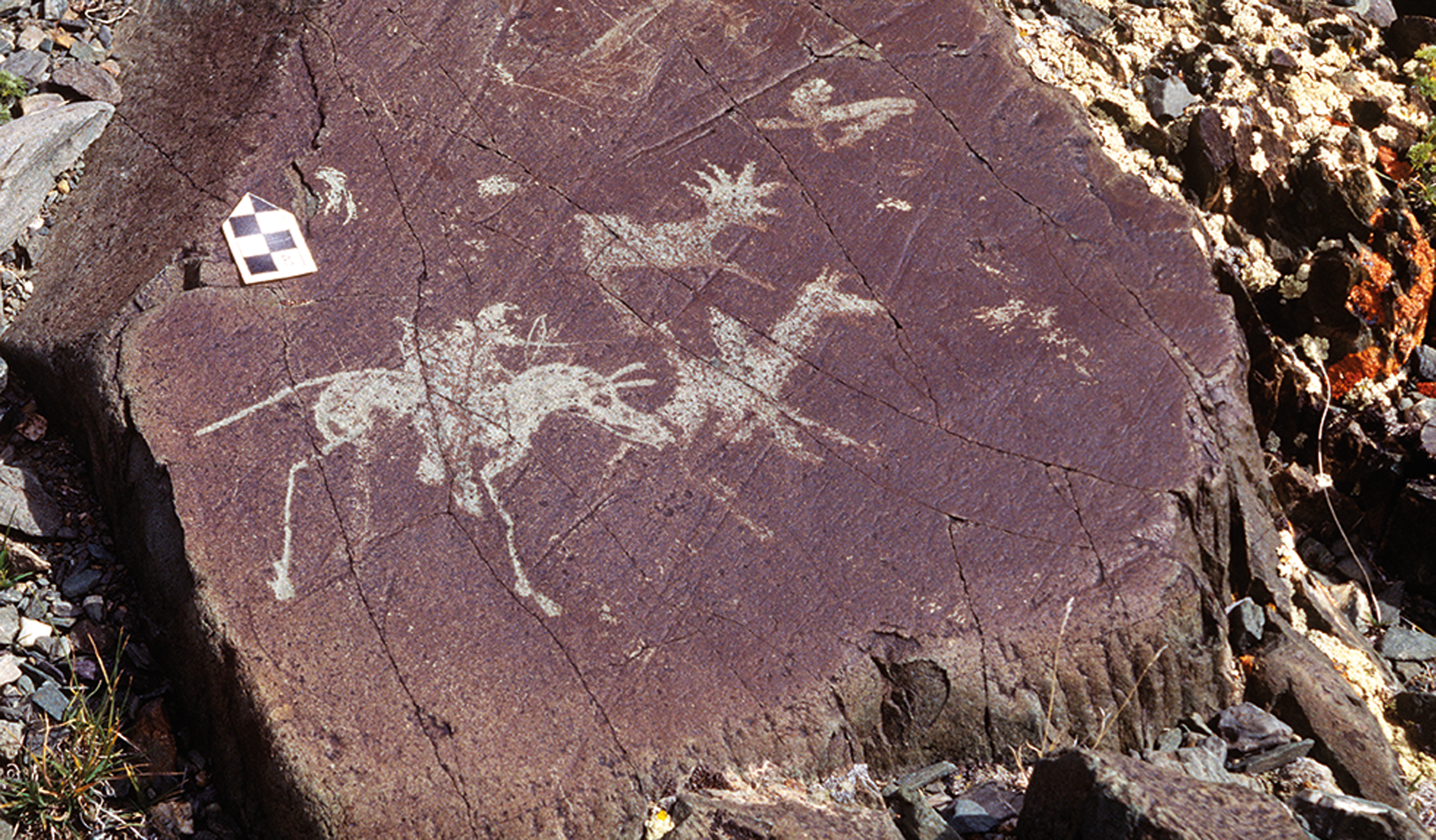
Figure 31. Rider with the hood, boots, recurve bow and quiver of an early Iron Age nomad. Pazyryk period. Baga Oigor complex, BO I. (Photograph: Gary Tepfer.)
Riding did not simply upend a millennia-long tradition of pedestrian pastoralism and transhumance; it also deeply impacted the herders’ relationship to space and time as they physically experienced their world. Consider a Bronze Age herder trudging on foot, surrounded by his animals and keenly aware of distance and changes in elevation, as well as the time it would take to move from one point to another. Rock-art imagery indicates that the herder of the Bronze Age was dressed in close-fitting clothes and carried his bow, quiver and perhaps a throwing stone and daluur. His concern was with accompanying and guarding the household, as well as with any hunting opportunities (Fig. 29). Contrast that with the experience of a herder on horseback, able to adjust to the natural pace of his flocks and far less impacted by elevation change or distance. A herder on horseback had a much larger view of his animals, of the surrounding landscape and of potential predators or poachers; as a consequence, he was able to drive and protect larger flocks.
We do not have representations of caravans clearly datable to the early Iron Age, but the burials from that period indicate a very different presentation of the individual. Males would have been dressed in close-fitting pants, warm boots and a hood-like head covering (Fig. 31); the bodies of both males and females would have been decorated with the highly stylized tattoos of animals (Barkova & Pankova Reference Barkova and Pankova2005; Rudenko Reference Rudenko and Thompson1970). The men almost certainly wore belts and plaques of gold-covered carved wood or of bronze (Chugunov et al. Reference Chugunov, Parzinger and Nagler2010; Polos’mak Reference Polos’mak2001; Polos’mak & Barkova Reference Polos’mak and Barkova2005; Rudenko Reference Rudenko and Thompson1970). Seated on a richly saddled horse, the riders’ pole-tops and ornaments would have announced their presence from a distance and from a height. Whether carried by elite members of society or more modestly by commoners, whether made of bronze, solid gold, or of wooden carvings covered with gold foil, the images inscribed on the riders’ attire and weapons—and most particularly those of elk, ibex, argali, horses and boar—would have served as formalized statements, transformed from the representation of natural animals to emblems of status, lineage, and perhaps gender. They were intended to identify the person of the rider, now removed by the horse’s size from the ground and separated by distance from the on-coming viewer.
These emblematic images carried by horse and rider, as well as literally on the tattooed body of the rider, invariably elevated the relative significance of signs of personal and group identity. At the same time, those changes in visual and personal style and the highly stylized character of specific imagery seem to have had a profound impact on the manner in which herders and hunters decorated the boulders and bedrock of their land. Rather than consulting the natural world around them, the artists turned to portable objects, perhaps those they were carrying on their own persons, and these became the models for a new kind of cultural imagery. At the same time, the radical reduction in the amount and quality of rock art in the early Iron Age probably reflects the simple fact that herders were on horseback, removed from the boulders and bedrock on which they would earlier have left their pictorial marks; their movement was more continuous, their opportunities to rest beside a boulder and peck out an image far more limited.
Some scholars have associated the radical change in art represented by the stylized elk image with an increasing stratification within nomadic society and a concomitant emerging political aggressivity (Andreeva Reference Andreeva2024). Within the Altai rock-art tradition this understanding is certainly supported by the frequent occurrence of highly stylized elk images superimposed over earlier Bronze Age imagery, as if in a statement of extreme aggressivity (Fig. 32) (Jacobson-Tepfer Reference Jacobson-Tepfer2015).
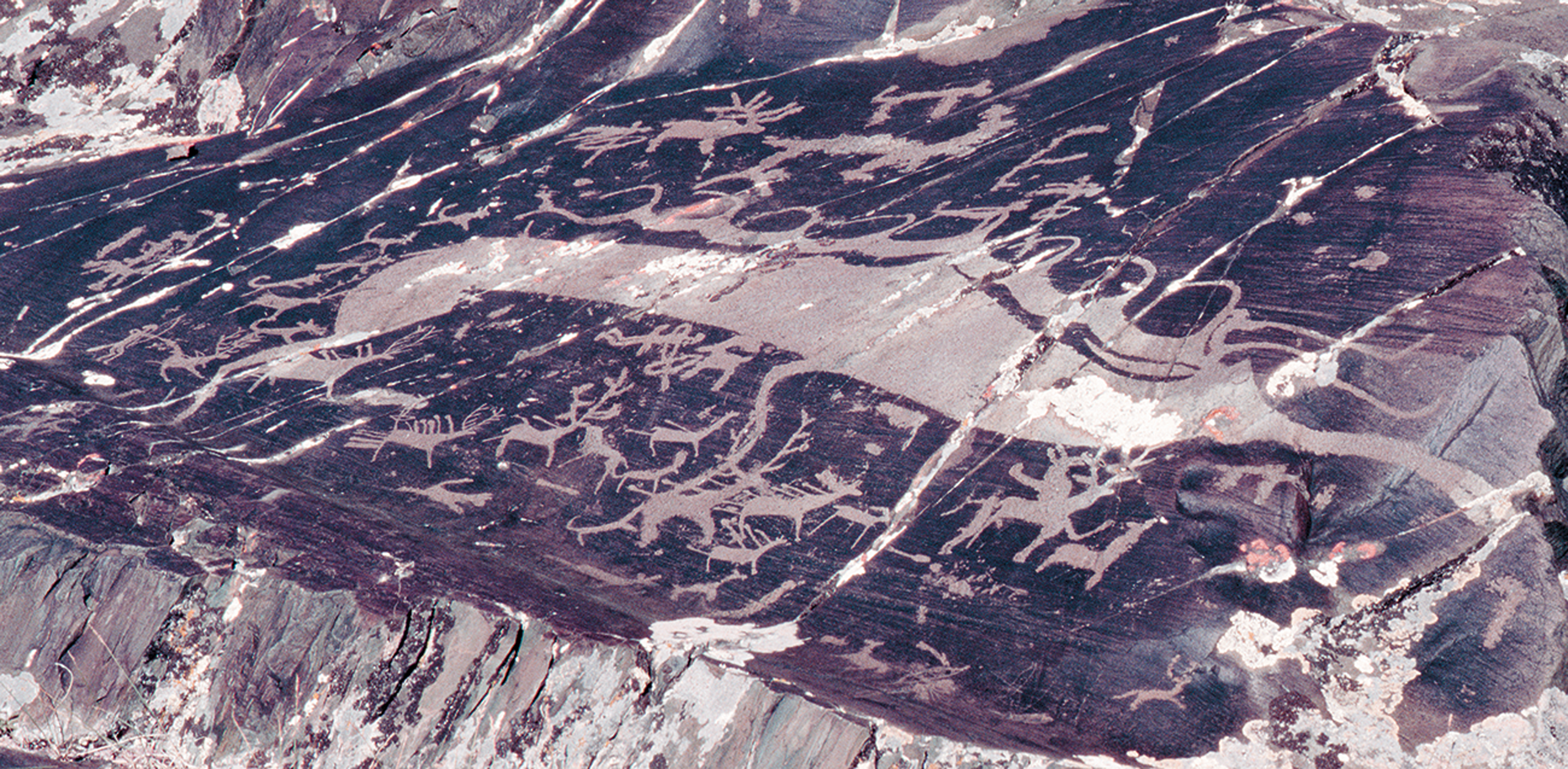
Figure 32. Stylized stag pecked over a Bronze Age hunting scene. Tsagaan Gol complex, SK_J13. (Photograph: Gary Tepfer.)
That theory may also be supported by the last distinctive transformation of the elk image in Altai rock art. An example is offered by the pale image of a stylized elk from the Tsagaan Gol complex (Fig. 33). The animal is presented as if partially crouched, its body very unlike that of a cervid but strangely reminiscent of the body of a wolf. At the same time, its antler rack is elaborate, taking the form of wave-like tines. In this respect this image recalls that from TS IV with which this discussion began (Figs 1–3). The shape of the elk’s head around the eye is reminiscent, also, of that other elk’s; and while the head of the TS IV image is drawn out into the long bill of a water bird, this animal’s head is drawn out into a shape more suggestive of a raptor’s hooked beak.
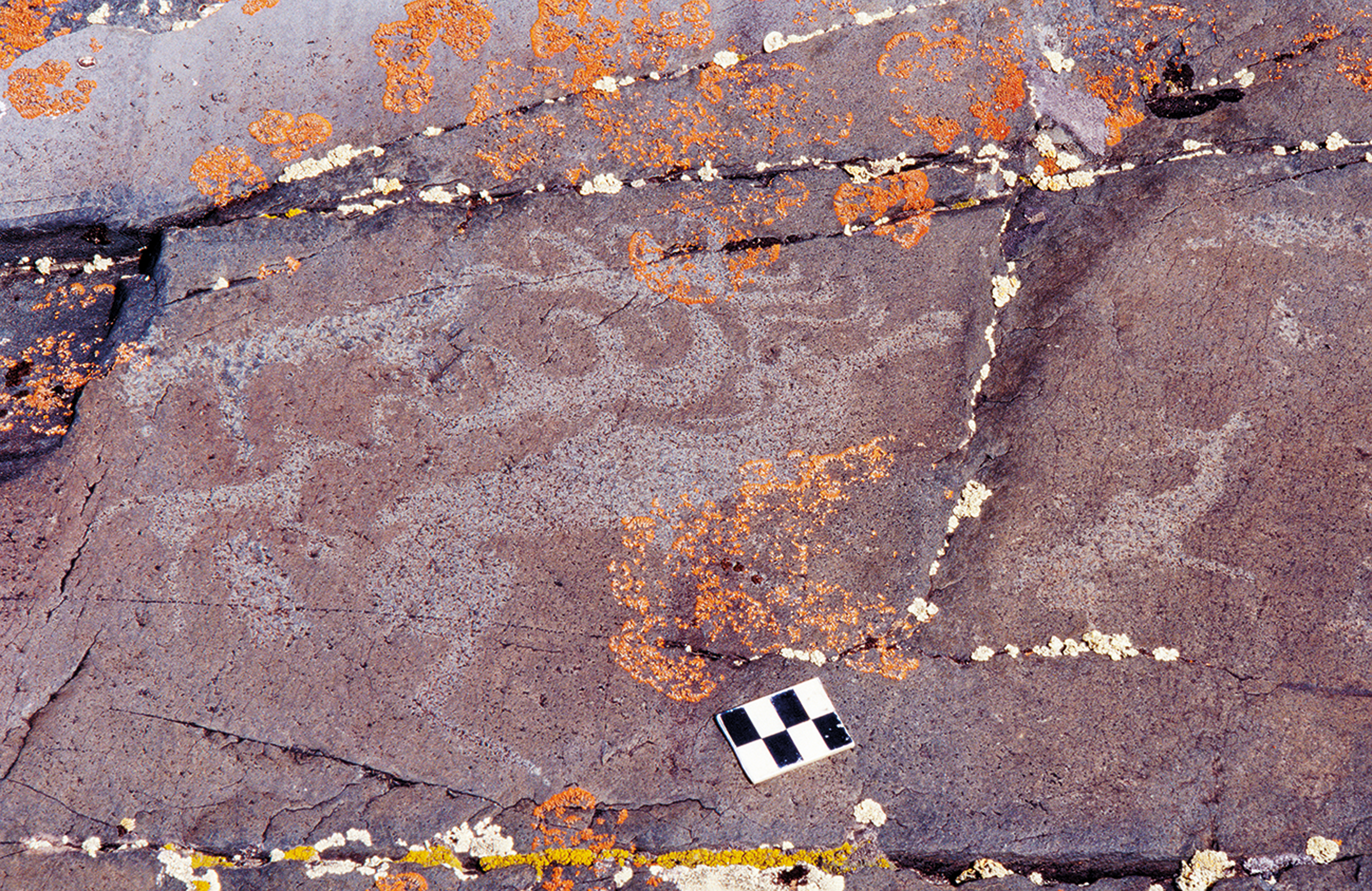
Figure 33. Bull elk, doe and wolves. Early Iron Age. Tsagaan Gol complex, KS_B1. (Photograph: Gary Tepfer.)
In the late Bronze–early Iron Age transition, the stylized formulations identified above had a way of crossing and merging, as if the artists of individual panels were picking and choosing from a variety of possibilities, all of them demonstrating an increasing separation from the natural animal. This is evident, for example, in the variety of elk images in a fine panel from the Tsagaan Gol complex (Fig. 34).
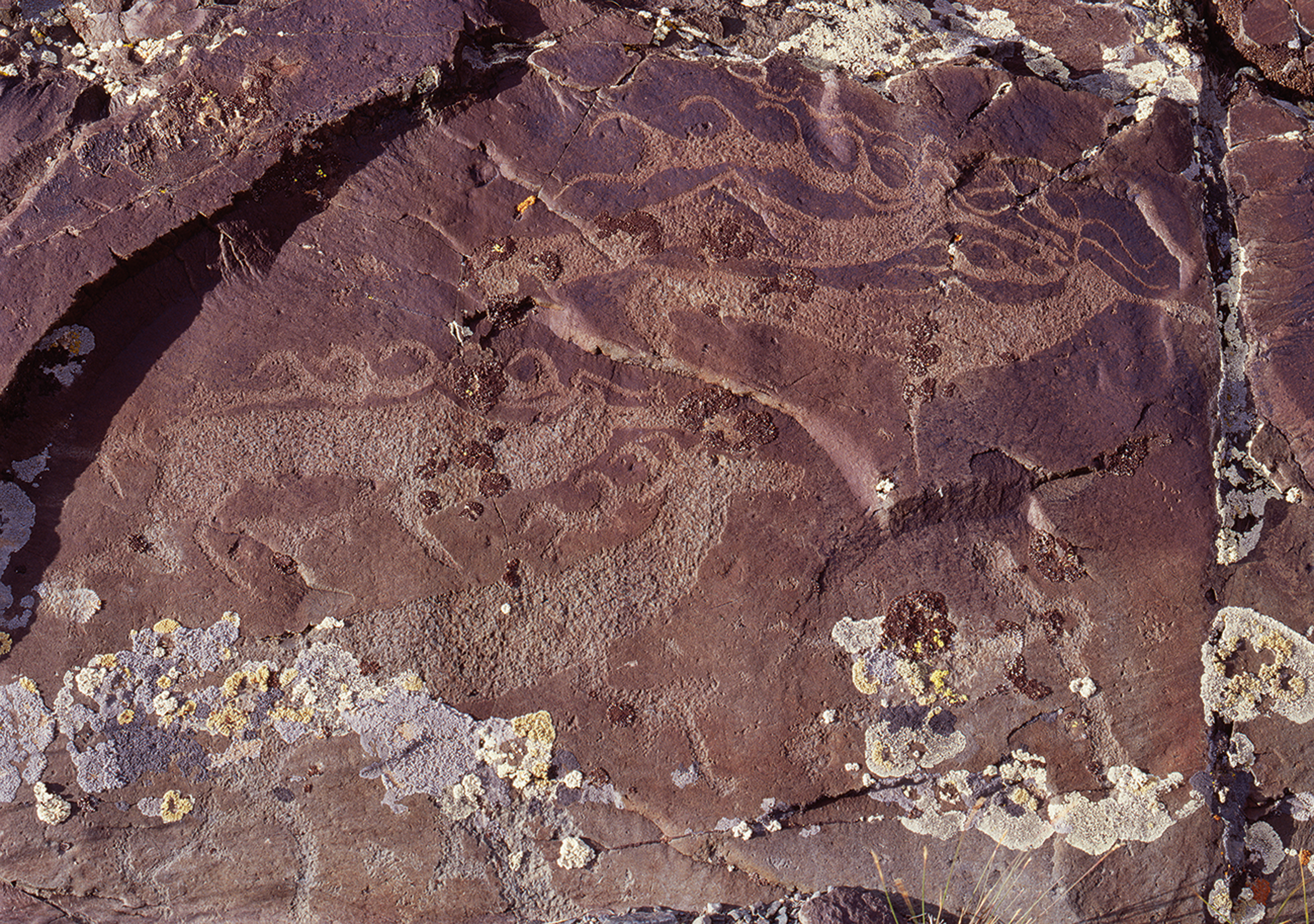
Figure 34. Panel of stylized elk. Tsagaan Gol complex, SK_G7. (Photograph: Gary Tepfer.)
On another panel from the Khar Salaa section of the same complex are five elk, like the others well pecked but highly stylized (Fig. 35). On this surface, the antlers of the elk vary considerably, from a wave-like form in the centre to a tree-like form in the largest animal on the right. Here, also, a small elk in the upper centre of the stone holds its body in a distinctive crouch more characteristic of a stalking predator than of its prey. There is yet another way in which these panels are removed from observation of the real world: herds of elk are never composed of mature antlered animals. The extent to which these deformations in form and fact refer to the emblematic character of the late elk image is also indicated by the convergence of the imagery in the Tsagaan Gol complex with imagery found in other parts of the Siberian Scythian world. For example, the elk in Figure 35 are so similar to a group from Mozaga-Komuzhap in the upper Yenisei basin as to suggest almost a single template transported from one region to another by horse-riding nomads (Devlet Reference Devlet2009, pls 35–38).
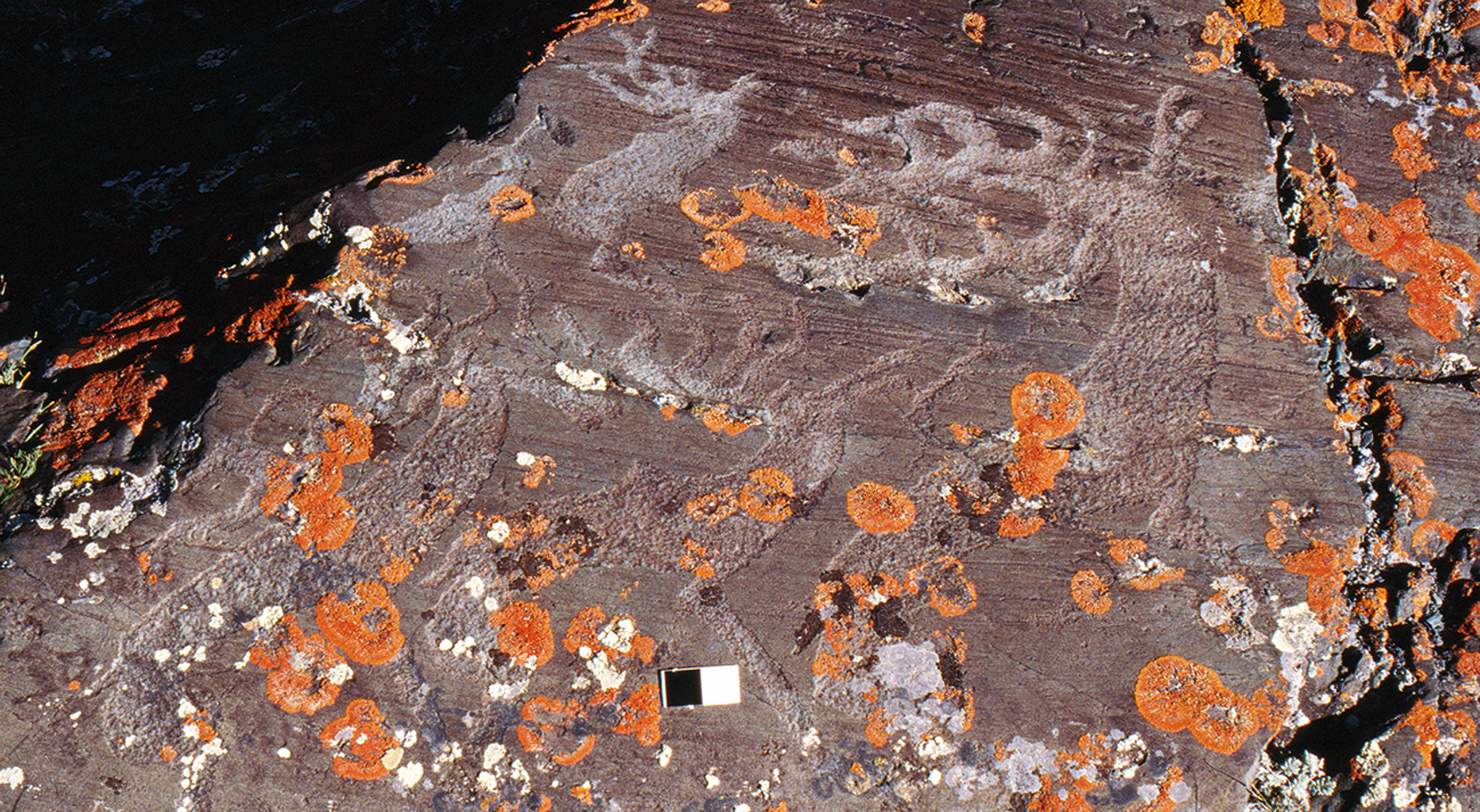
Figure 35. Five stylized elk. Early Iron Age. Tsagaan Gol complex, KS_B8. (Photograph: Gary Tepfer.)
The latest renditions of the Siberian Scythian stag image were the final statements of what had once been an impressive, even majestic animal. In some cases, the animal’s mouth became an exaggerated beak, as of a large beaked bird or even of a raptor. Elsewhere, the deformation of the animal’s head and body increasingly suggests a wolf, as if the two animals had become fused into one body (Fig. 36). In these cases, it is impossible to ignore the continued deformation of the stag image in distant renditions of the late Siberian Scythian world, including materials from late Scythian burials (Jacobson Reference Jacobson1984), or from Xiongnu finds in northern China (Andreeva Reference Andreeva2024), or most starkly in the case of the stag-wolf guardian figures from the Sarmatian burials at Filippovka in the Ural river basin (Aruz et al. Reference Aruz, Farkas, Alekseev and Korolkova2000; Reference Aruz, Farkas and Fino2006).
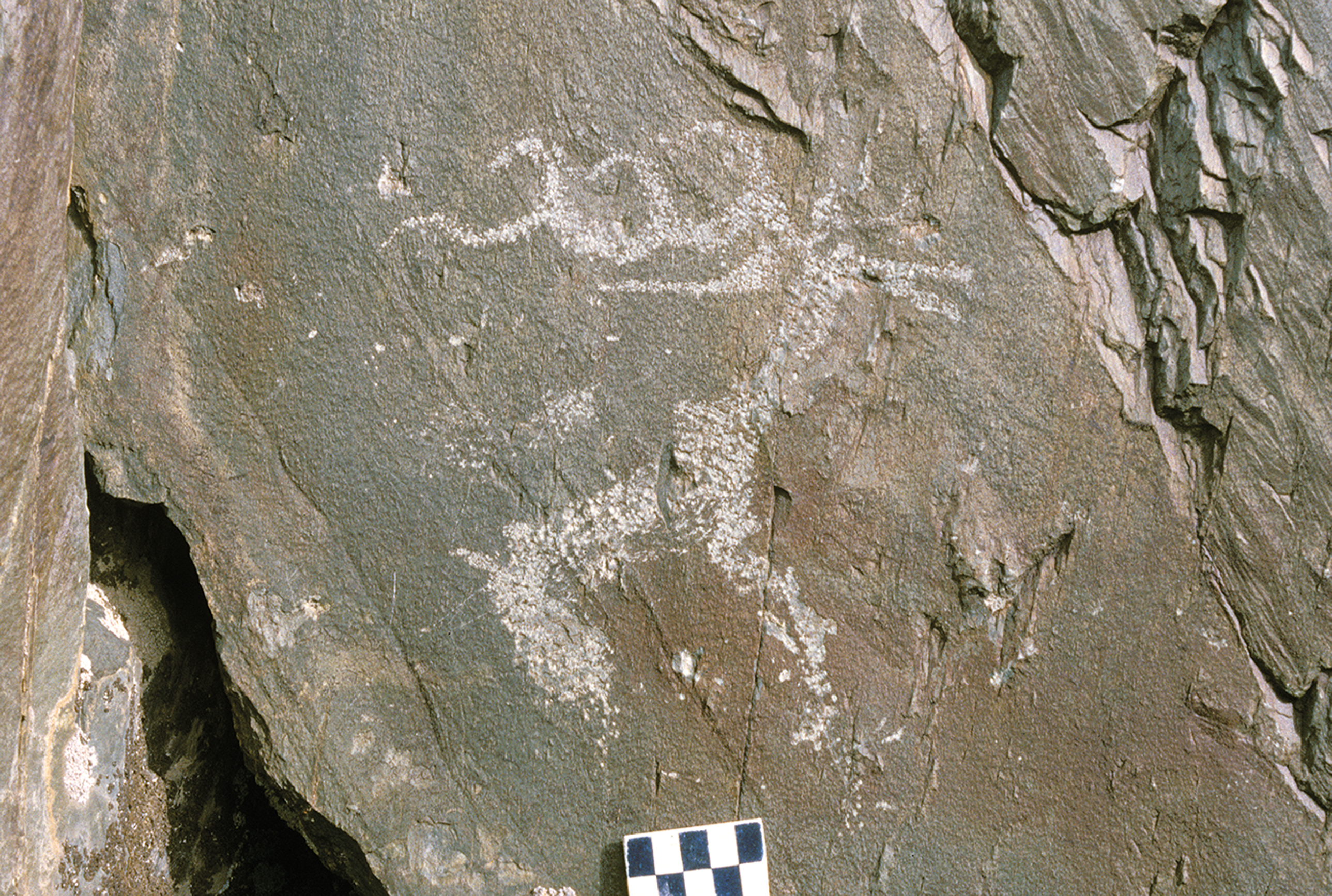
Figure 36. Elk with wolf-like body, resembling the guardian figures at the Sarmatian burials of Filippovka. Early Iron Age. Tsagaan Gol complex, SK_K10. (Photograph: Gary Tepfer.)
It would be incorrect to say that realistic elk disappeared altogether from rock art of the Altai region, but the instances in which they were represented were remarkably diminished in number, and those that persisted were often radically transformed. This must have been partially dependent on natural causes: by then the decisive loss of forest must have caused elk to have withdrawn from much of the Mongolian Altai to the more heavily wooded slopes on the northern and western sides of the Altai uplift. Perhaps, also, the image of the elk could not survive its transformation into an emblematic form within the largely ceremonial art of the Siberian Scythians and their descendants. Elk did continue to be represented in rock art in the Russian Altai, particularly during the Turkic Period; but what was once a powerfully realistic animal, and then an animal of grace and vitality, effectively disappeared from the rock-art tradition of the extended Altai-Sayan region.
The history of the elk image in the Mongolian Altai offers a view from within the mind-set of generations of people, a reflection of the affective life of culture as significant as the material remains of sub-soil archaeology. While the latter is embedded within a stratigraphic framework, the transformation of imagery reveals the fitful self-description of the human imagination. In this case, the examination of the elk image challenges the general tendency to remove the study of pictorial elements from their larger contexts—be they geological, stylistic, or social—or to ignore the centrality of an evolving iconography within the archaeology of any cultural tradition. This study challenges the too-frequent recourse to neat explanations—such as shamanism, for example—for which it is impossible to reconstruct an ancient supporting context. Maddeningly elusive as may be the shape of iconographical significance within the prehistoric context, it is essential to ferret out the pattern of a motif’s twists and turns over deep time, for these shifts reveal the psychology of people embedded in an ever-changing natural and social environment.
Disclaimer
The author is the sole responsible individual for the written materials included in this article. Primary funding for the field work underlying this article was drawn from the Maude Kerns Chair at the University of Oregon. All but one of the photographs are the work of Gary Tepfer.

